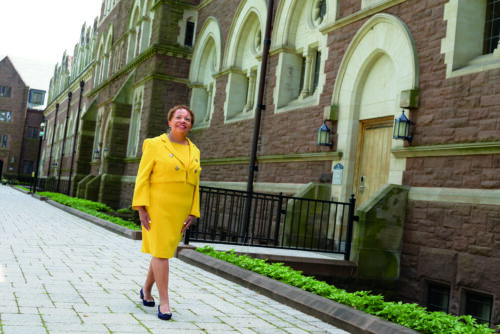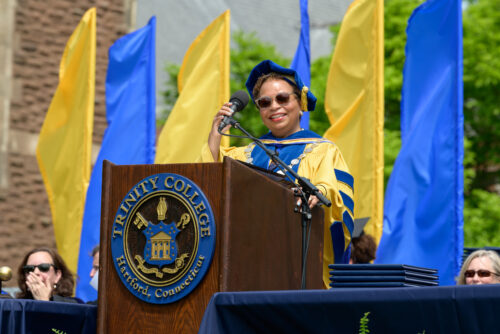The Legacy of Joanne Berger-Sweeney
Celebrating eleven years of leadership and the strength of the Trinity community today.
President Joanne Berger Sweeney will retire from Trinity College at the end of the 2024–25 academic year. The Trinity community has accomplished much under her leadership over the past decade. We invite you to take a look at Trinity moments in photos, videos, and stories, and be part of honoring a legacy of leadership.
10 Trinity Accomplishments Through Stories from the Last Decade
Under President Berger-Sweeney’s leadership, Trinity has undergone transformational changes in student enrollment, satisfaction, and post-graduation success in the past 10 years. In 2015, the Trinity admissions process became test-optional and the College increased financial aid for undergraduate students by 50 percent, enriching the socioeconomic, racial, and international diversity of the student body. The Bantam Network created a novel way for incoming students to build relationships socially and academically in their first days on campus. Throughout their time at Trinity, students can be involved with the new Center for Career & Life Design, connect with alumni through the Bantam Career Network, explore internships, and participate in research with faculty mentors. After graduation, alumni have seen great success; a “first destinations” survey of the members of Trinity’s Class of 2023 found a 96.3 percent total placement rate, which reflects alumni who are employed full-time or part-time, continuing their education, serving in the military, or volunteering.
Introduced in 2021, the Trinity Plus curriculum puts new emphasis on credit-bearing co-curricular experiences, such as internships. In addition to 32 core academic credits, students earn three additional credits, which may take the form of a faculty-designed experiential certificate, allowing students to pursue deeper, more hands-on studies in highly focused areas as they prepare for their next steps after Trinity. The curriculum incorporates a wellness component to promote personal well-being. With dynamic and talented faculty members, Trinity has been able to expand its course offers and programs of studies, which include a graduate certificate in urban planning—the first of its kind in the state of Connecticut. Trinity students and alumni have been continually honored for their scholarship, with Trinity being recognized as a top producer of Fulbright U.S. Students.
President Berger-Sweeney led the way as Trinity continuously worked toward greater and broader inclusion, while caring about all people. The Campaign for Community and Bridging Divides initiatives emphasized understanding and dialogue. Trinity created an Office of Diversity, Equity, and Inclusion and hired its first vice president for DEI, in addition to hiring new faculty members who would help to increase the diversity of perspectives in the classroom. Trinity took serious looks at its own past and practices and issued a report from the Task Force on the Status of Women at Trinity, a Title IX audit for athletics that included next steps, and a detailed Action Plan for Racial Justice, all to help improve the campus climate. Trinity has been recognized for several of its DEI efforts, including through a Higher Education Excellence in Diversity (HEED) Award and 5-star ratings from the Campus Pride Index.
Engagement has taken many forms over the past 10 years. The entire Trinity community celebrated the College’s Bicentennial in 2023, with more than 11,000 attendees at 47 events, including the Alumni Bicentennial Celebration and the Bicentennial Gala. Trinity’s engagement in Hartford expanded through the launch of the Center for Hartford Engagement and Research (CHER) and the opening of the Innovation Hub downtown. Across the Atlantic, Trinity celebrated more than 50 years of its Rome Campus. Students continue to demonstrate their civic engagement, with Trinity recognized as a 2022 ALL IN most engaged campus for college student voting. Meanwhile, alumni continued to show confidence in Trinity’s mission through a survey, and the entire community supported the College’s All In comprehensive campaign, Trinity’s most ambitious fundraising effort to date.
Along with the Board of Trustees and her cabinet, President Berger-Sweeney made the maintenance and beautification of campus a priority, helping to preserve and improve a place that holds fond memories for so many people. Among the high-profile projects were the repairs to the Chapel, a major addition of a Wellness and Recreation Center to the Ferris Athletic Center, and maintenance of the underground heating and air conditioning pipes. Formerly known as Vernon Social, the Cornelia Center—named in honor of Cornelia Parsons Thornburgh ’80 —was renovated to become the new home to Trinity’s Career and Life Design Center, which continues its mission to empower students and graduates to be active agents in designing their careers. The dedication of the Manuel and Maria Luisa Lopes Borges Admissions Center followed a gift made by the family to establish a financial aid endowment that would ensure future generations would have access to a Trinity education. Known to impress visitors and entice new members to the Trinity community, the campus was included on a list of “64 Most Beautiful Campuses in America” by Architectural Digest and was formally designated as an arboretum by the independent accrediting agency ArbNet. The campus is home to more than 1,500 trees and dozens of tree species spread across about 100 acres. At the conclusion of the Bicentennial celebration, the core of campus—including the Long Walk and the Chapel—was added to the National Register of Historic Places as the Trinity College Long Walk Historic District.
New partnerships, centers, programs, and buildings demonstrate Trinity’s increased support of innovation and creativity over the past 10 years. The Crescent Street Center for the Arts and Neuroscience (CCAN) embodies the liberal arts by bridging the fields of neuroscience and the arts, while the Gruss Music Center features a performance hall, an electronic music lab, a state-of-the-art recording studio, and four practice rooms. Trinity entered a partnership with global consulting and technology company Infosys to bridge the liberal arts and digital technology and served as a founding partner of a medtech accelerator in Hartford. At the College’s downtown location at Constitution Plaza, Trinity’s Innovation Hub houses the partnership with Infosys; the Liberal Arts Action Lab, Trinity’s community impact initiative in partnership with Capital Community College; and programming for students under the new Entrepreneurship Center.
The formation of Trinity’s Center for Hartford Engagement and Research (CHER) signaled a refreshed focus on the College’s relationship with neighbors and partners in its home city. The Liberal Arts Action Lab and Trinity’s expanded connections with Hartford schools are just two of the many opportunities students have to get involved in Hartford. For more than 25 years, the College has hosted Dream Camp, a summer camp for local children that was awarded a $1 million grant by the state of Connecticut in 2022. In recent years, Trinity launched its Volunteer Income Tax Assistance (VITA) program at Trinfo and was recognized for its community partnerships with Campus Compact’s Richard Guarasci Award for Institutional Transformation. Trinity also began partnering with Hartford HealthCare for health care, behavioral health services, and sports medicine for students. Additionally, a new Bicentennial Hartford Scholarship will increase the enrollment of local students at Trinity.
During the past 10 years, Trinity’s administration has reduced operating budget deficits and has seen the endowment nearly double, to $800 million. During the same time period, Trinity was able increase financial aid and has experienced a rise in the number of student applications, which went up 17% in 2024. The College made a significant financial pivot at the start of the COVID-19 pandemic, reducing budgets where necessary to ensure the continued operation of the institution during challenging times. More funds were shifted to essential support of students who returned to campus in fall 2020, when the College begin an intensive schedule of COVID testing. A major business decision was the new partnership with Hartford Healthcare, which has transformed sports medicine, health care, and behavioral health services for students and the entire Trinity community. Through both direct and induced spending, Trinity’s economic impact on the city and state economy amounts to $340 million annually, demonstrating the financial benefit the College has to the region. The financial future of Trinity is being driven by the College’s most ambitious fundraising effort to date, the All In comprehensive campaign, the pillars of which focus on building financial aid, supporting the student experience, and expanding the academic curriculum.
Under President Berger-Sweeney, Trinity created the Analytics and Strategic Initiatives Center (ASIC), overseen by the chief data officer, to advance the college’s use of data, research, and analysis to inform decisions and guide planning and evaluation. As a neuroscientist, Berger-Sweeney always seeks to collect and be informed by data. She and her leadership team have used surveys and other tools to measure the sentiments and needs of constituents, including students, alumni, faculty, and staff. The efforts have focused on using data to measure and raise rates of retention and satisfaction, improve campus climate, and inform faculty hiring practices, such as the College’s recent Special Opportunity Hiring (SOH) initiative that welcomed 18 tenure-track faculty members over three years. Additionally, a report from the Task Force on the Status of Women at Trinity College informed and guided the College’s efforts to increase the number of tenure- and tenure-track female faculty members and to reach gender parity among the faculty.
As part of the Summit strategic plan, Trinity has prioritized an ongoing commitment to decreasing energy consumption, improving campus energy efficiency, and engaging in an array of conservation efforts during President Berger-Sweeney’s tenure. The College hired its first sustainability coordinator and has installed solar panels, fuel cells, and electric vehicle charging stations on campus. Trinity’s dining areas and residence halls have established practices to support sustainability, and student groups including Green Campus encourage every member of the community to take actions to be more sustainable in their daily lives. The principles and tasks set forth in Trinity’s Sustainability Action Plan support the college’s goals to take action to significantly reduce greenhouse gases and ultimately to achieve carbon neutrality.
A Visual History of the Joanne Berger-Sweeney Years
A Visual History of the Joanne Berger-Sweeney Years
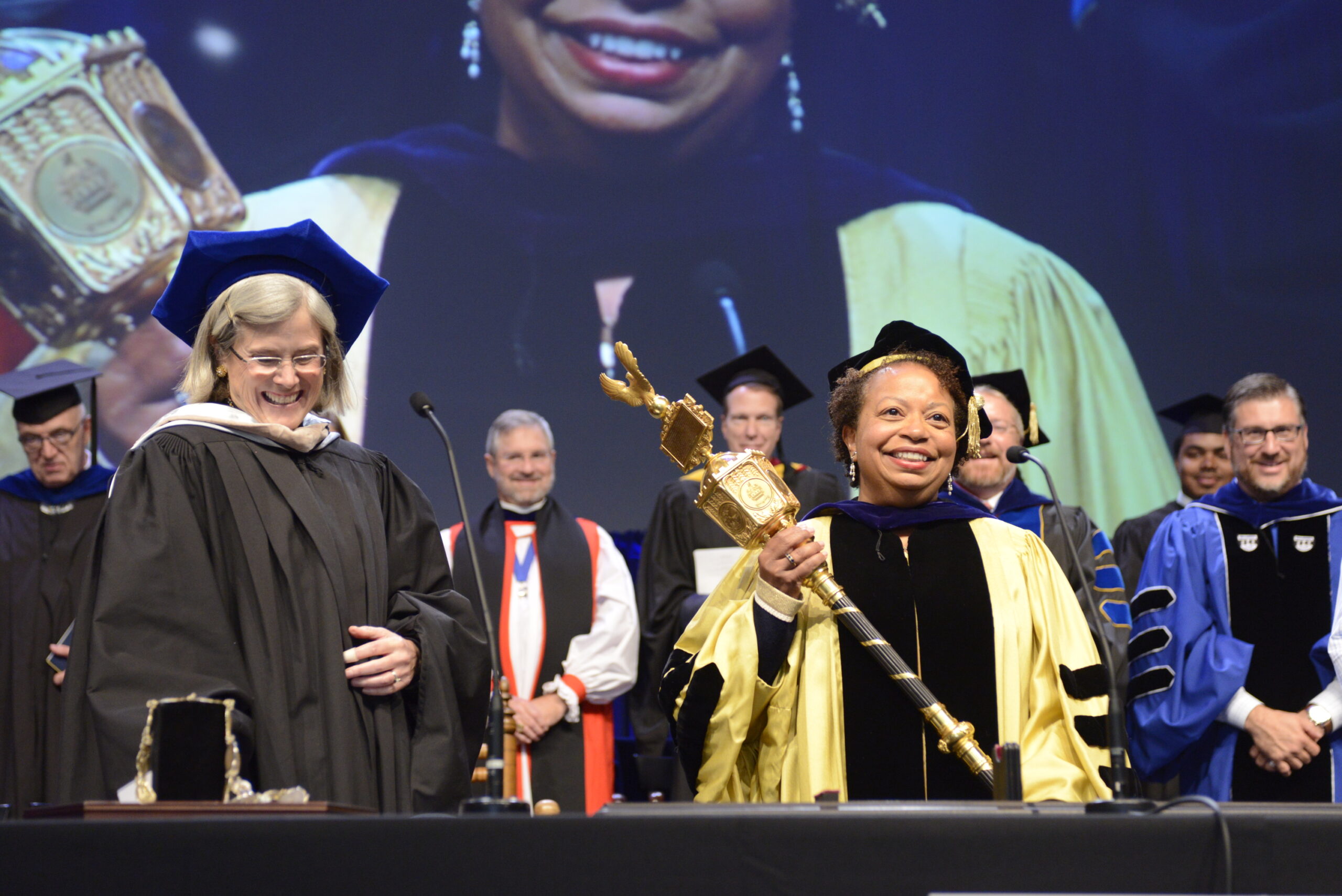
Joanne Berger-Sweeney is inaugurated as the 22nd president of Trinity College on October 26, 2014.
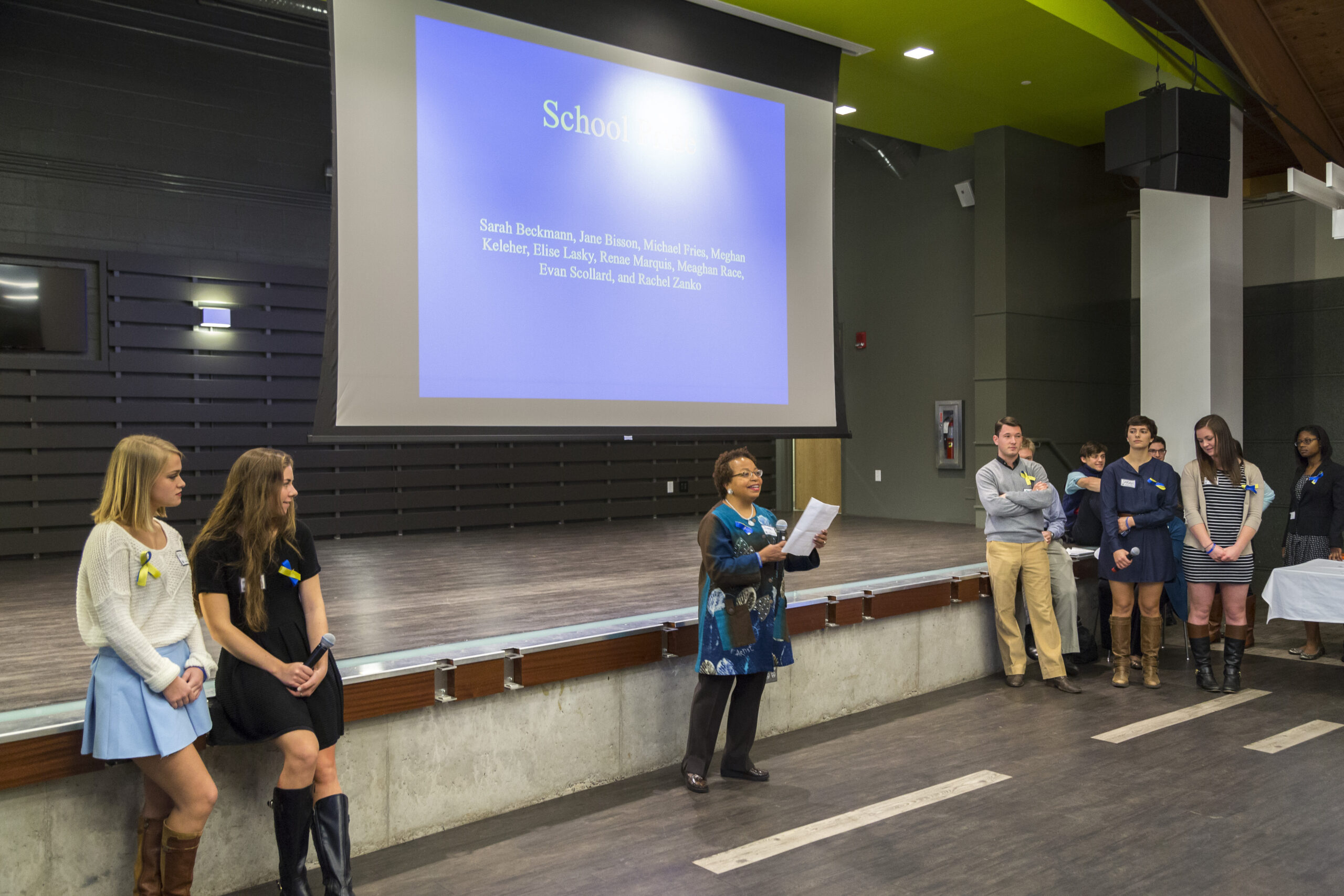
President Berger-Sweeney presents at the Campaign for Community in 2015 which was created to identify specific means of improving campus climate around gender and all forms of diversity.
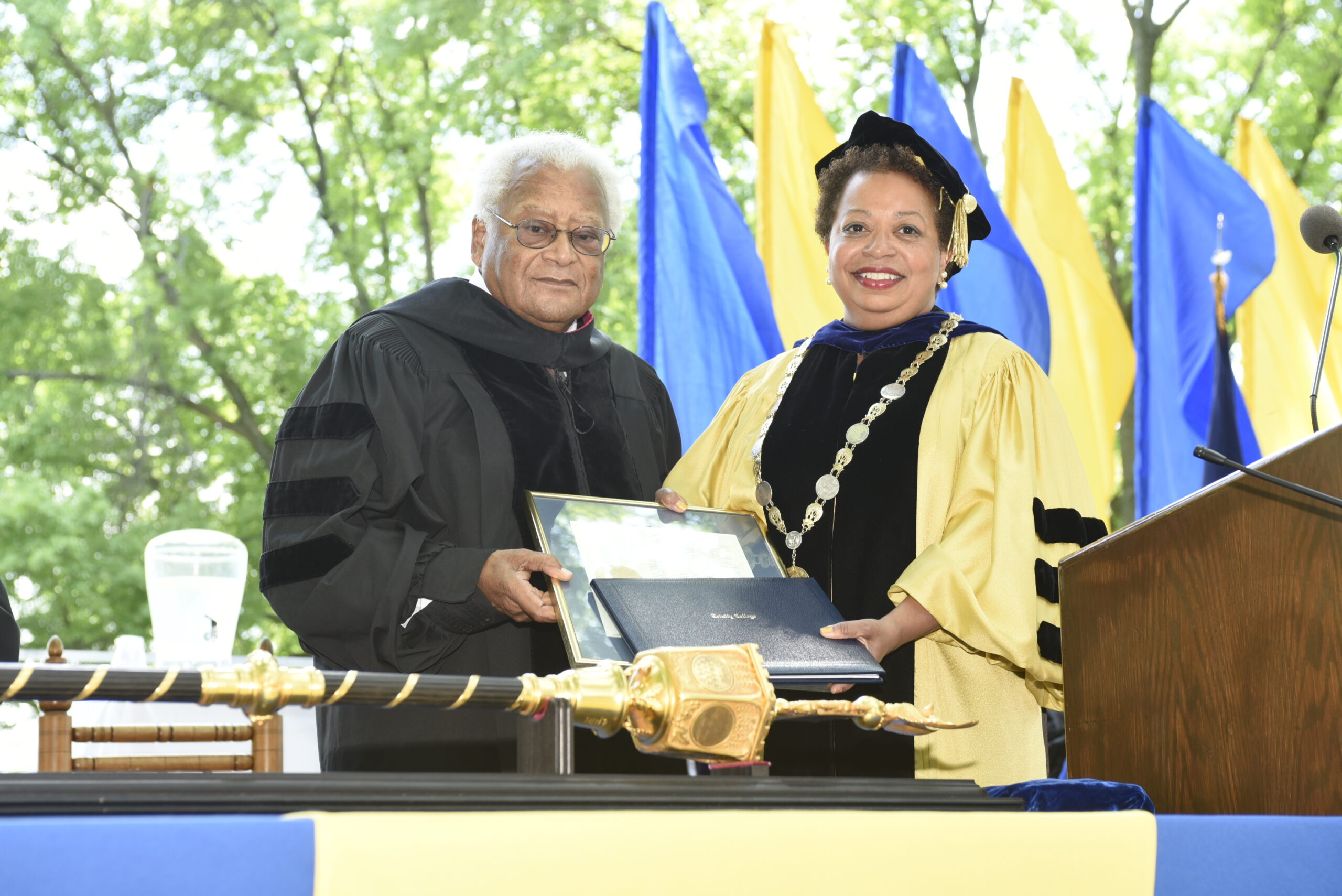
President Berger-Sweeney presents the Reverend James Morris Lawson Jr. with an honorary doctor of divinity degree at Commencement 2015.
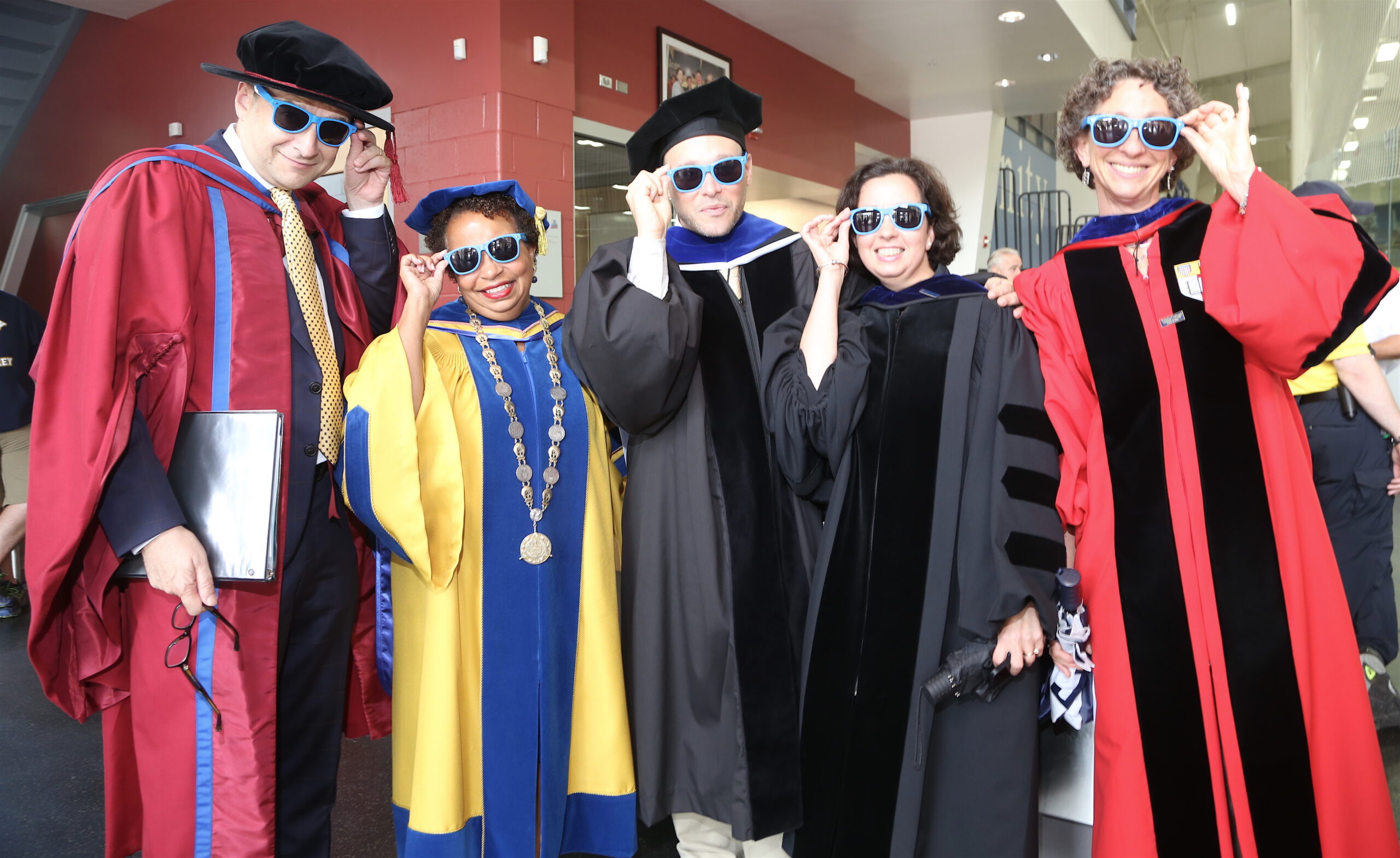
President Berger-Sweeney and members of her senior staff pose following Convocation ceremonies for the Class of 2020 in 2016.

President Berger-Sweeney dons her blue and gold and celebrates Homecoming with students in 2016.
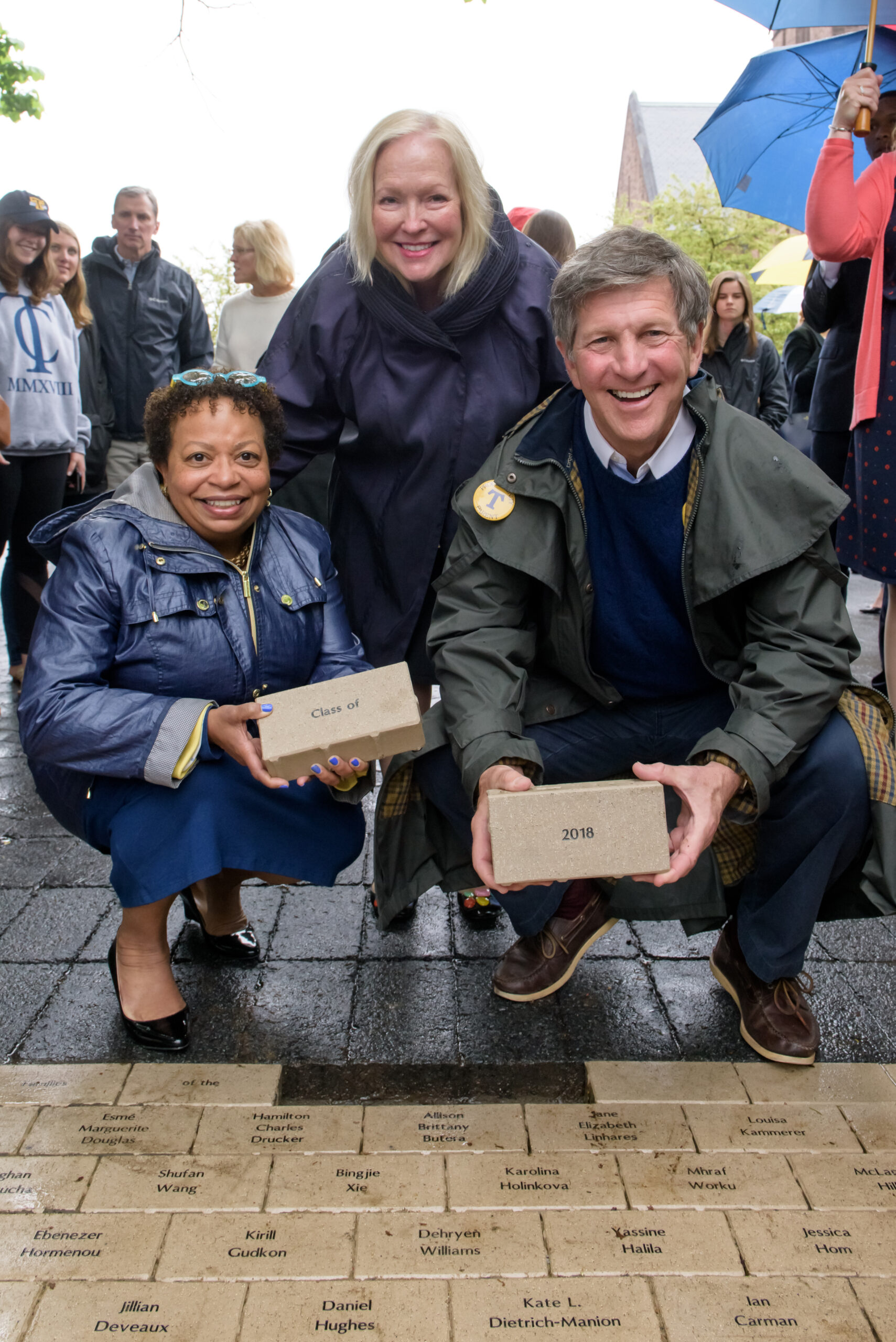
President Berger-Sweeney began a new tradition with the Class of 2018–laying bricks along the Lower Long Walk with students’ names. Here she poses with Martha Dippell and Danny Korengold ’73, P’09, ’12, ’14, ’18 at the first ceremony.

President Berger-Sweeney prepares to throw the first pitch at a Hartford Yard Goats game on August 29, 2018.

President Berger-Sweeney and Banty lead Trinity staff, students, and alumni to participate in the pre-game flag ceremony during Homecoming Weekend in October 2018.
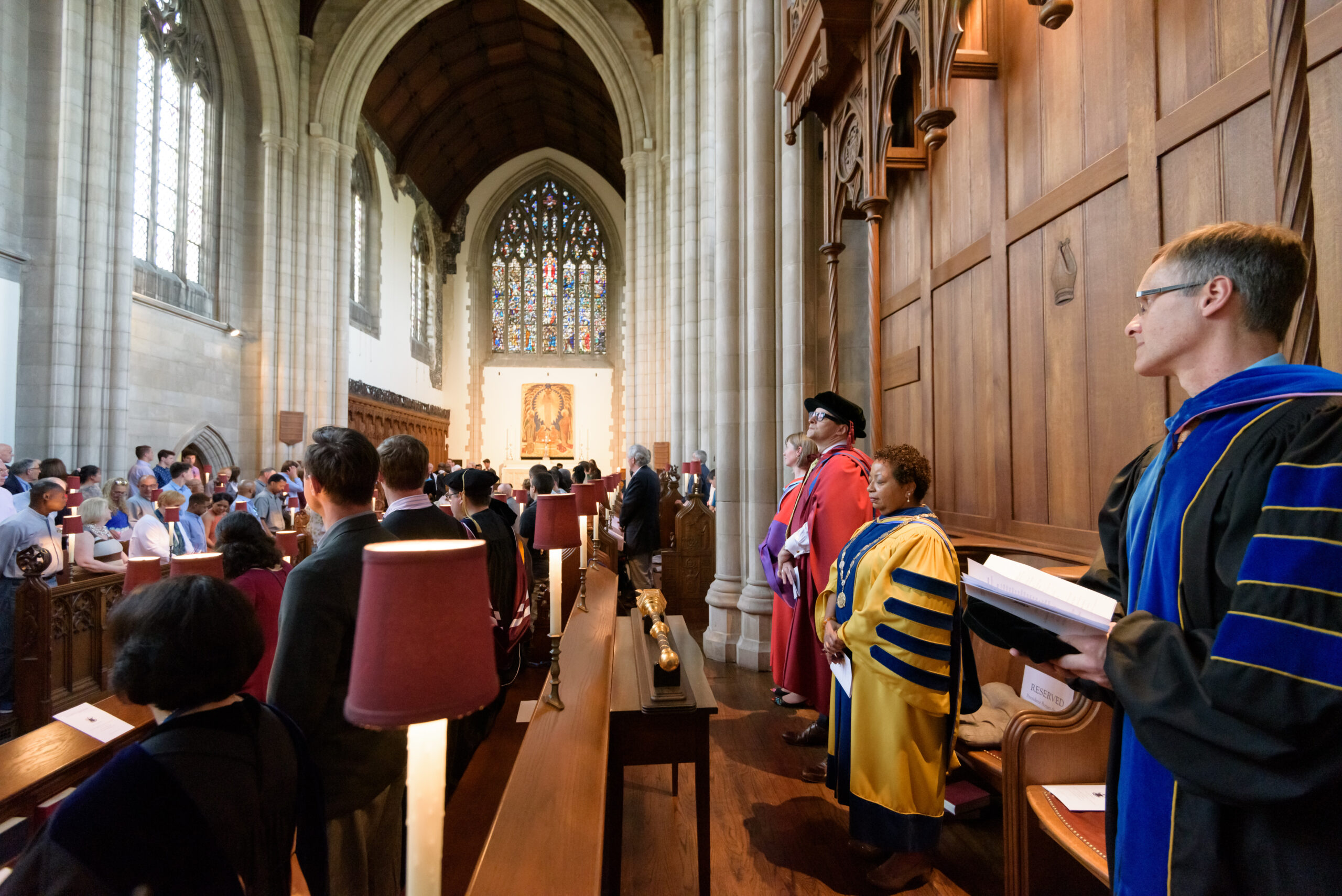
President Berger-Sweeney attends Trinity’s Baccalaureate in spring 2019.
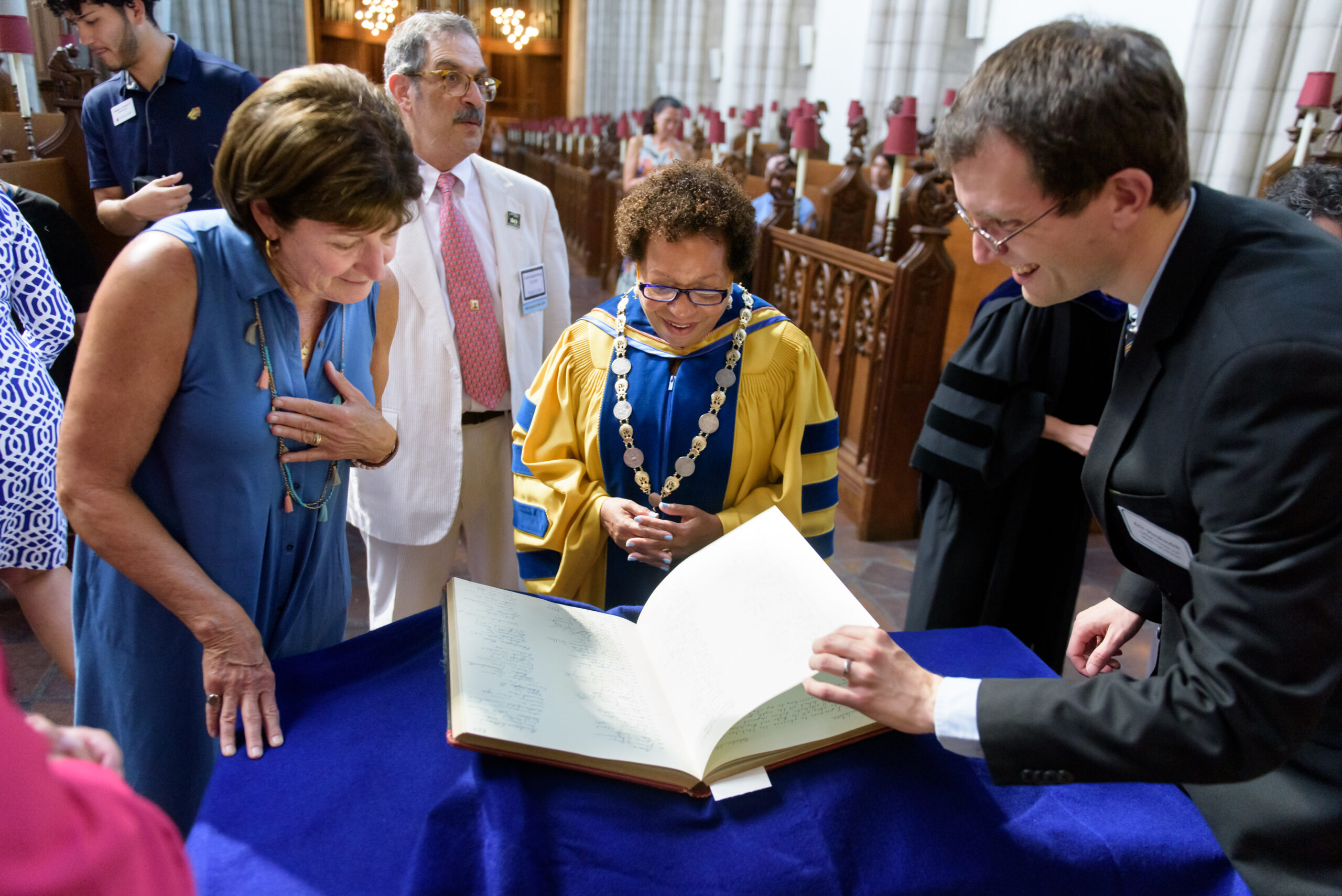
President Berger-Sweeney kicks off the academic year at Convocation 2019.
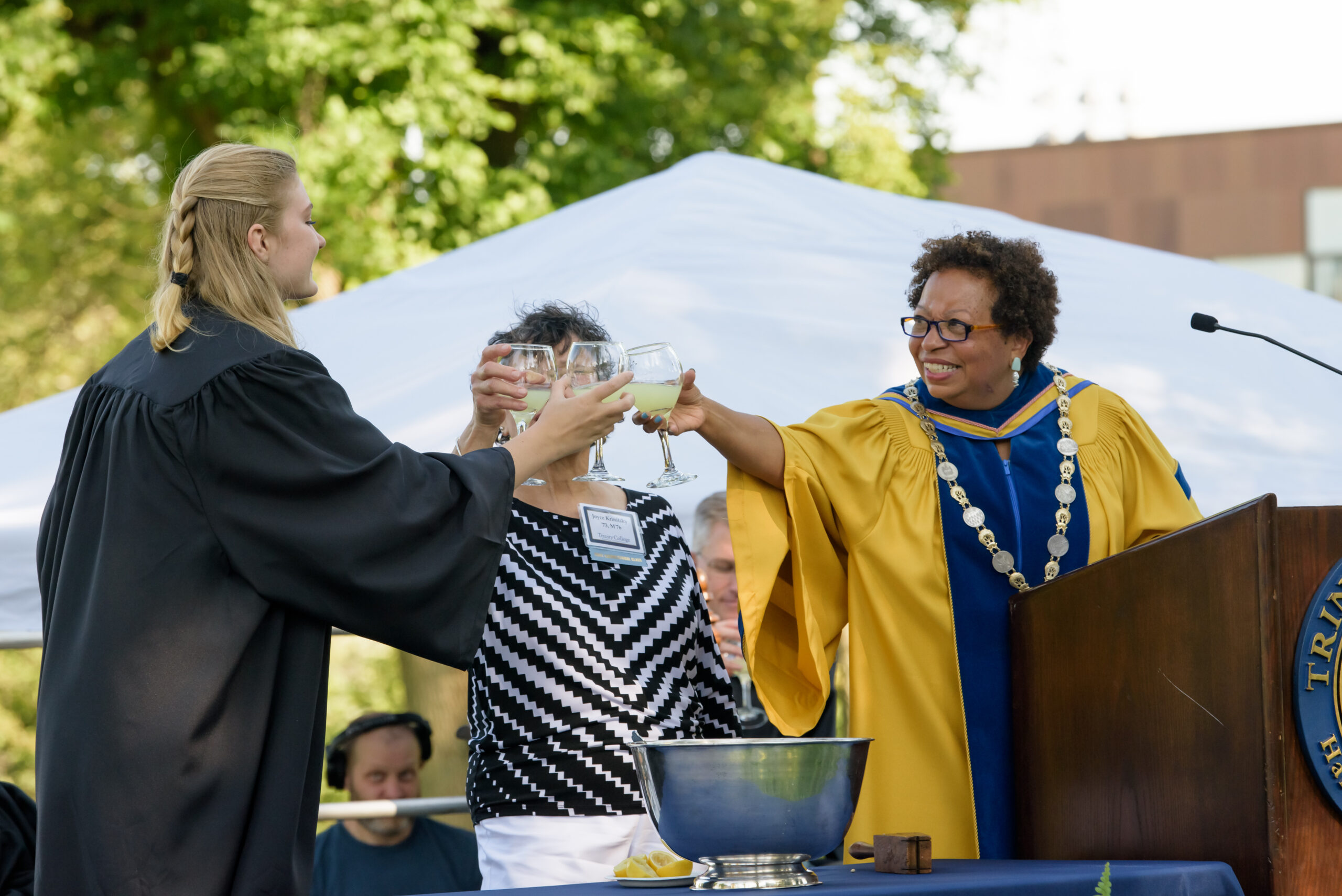
The traditional lemon toast is a reminder of the College’s earliest days, when a lemon squeezer was the subject of student hijinks. Here, President Berger-Sweeney raises a glass to Trinna Larsen ’19 and Joyce Krinitsky ’73.
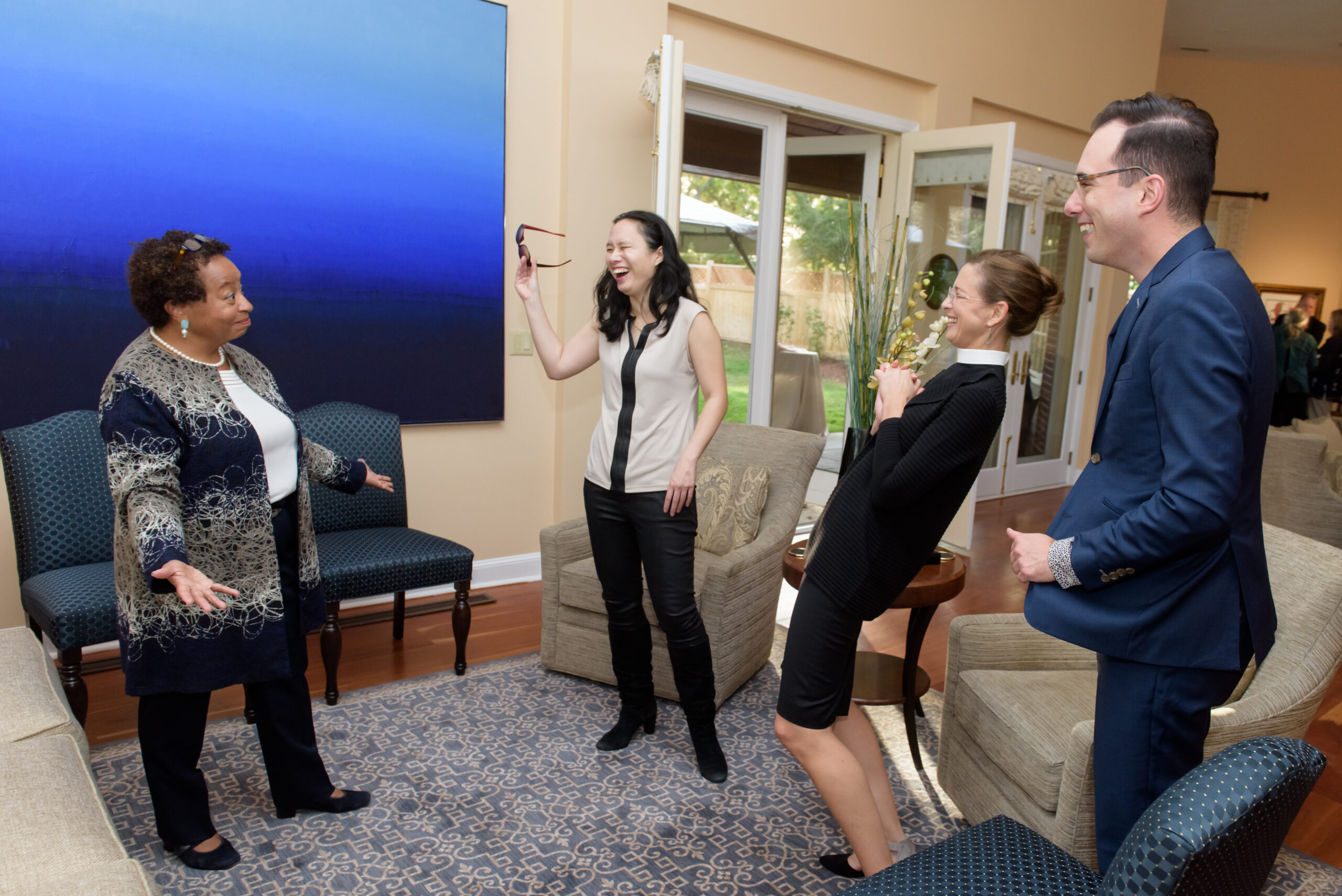
During a reception at the president's house, President Berger-Sweeney shares a laugh with Hartford Symphony Orchestra Conductor Carolyn Kwan (center), former Chaplain Rev. Allison Read, and Director of Chapel Music Christopher Houlihan ’09.
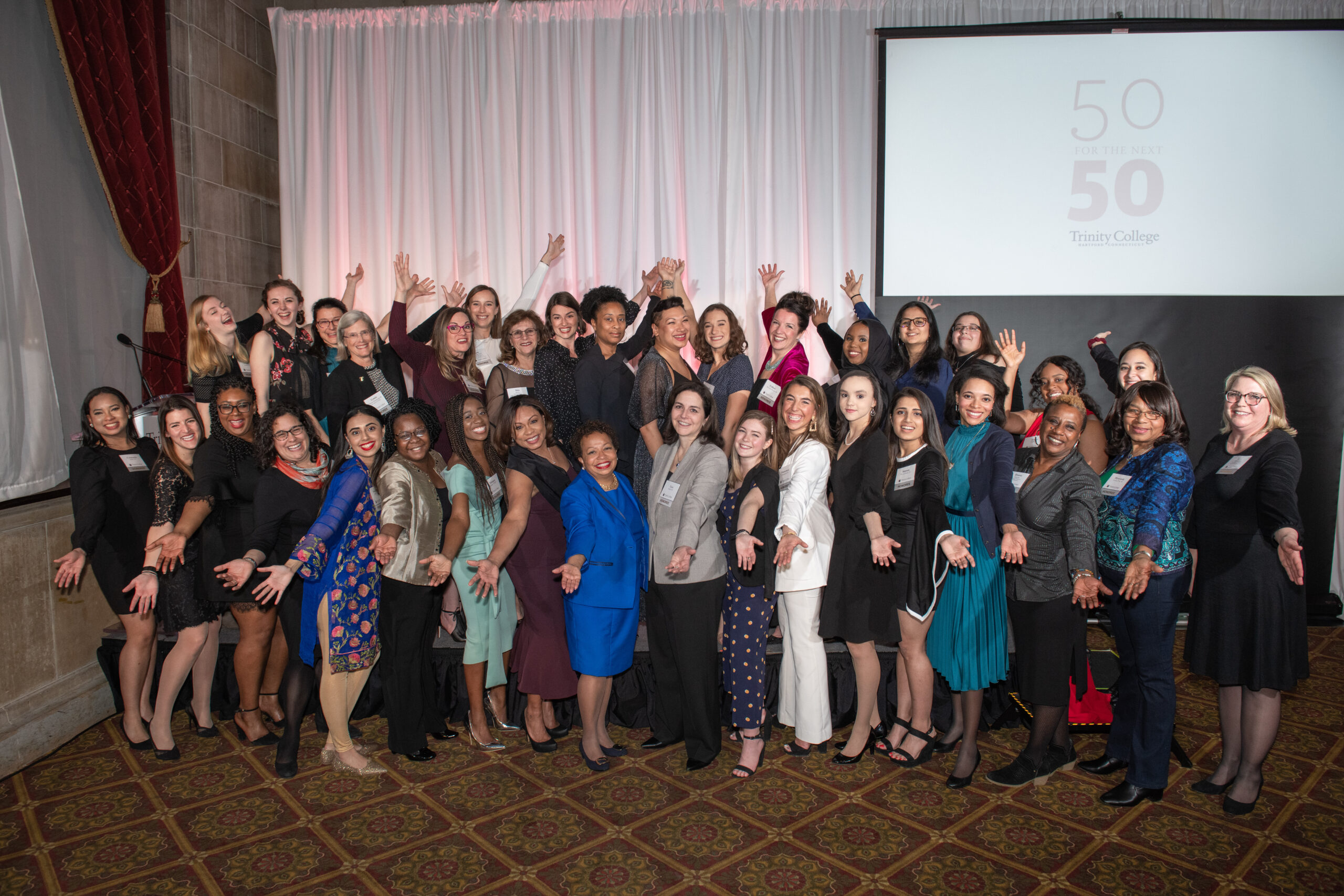
President Berger-Sweeney with fellow honorees at Trinity College's ’50 for the Next 50‘ Gala at the Society Room in Hartford.
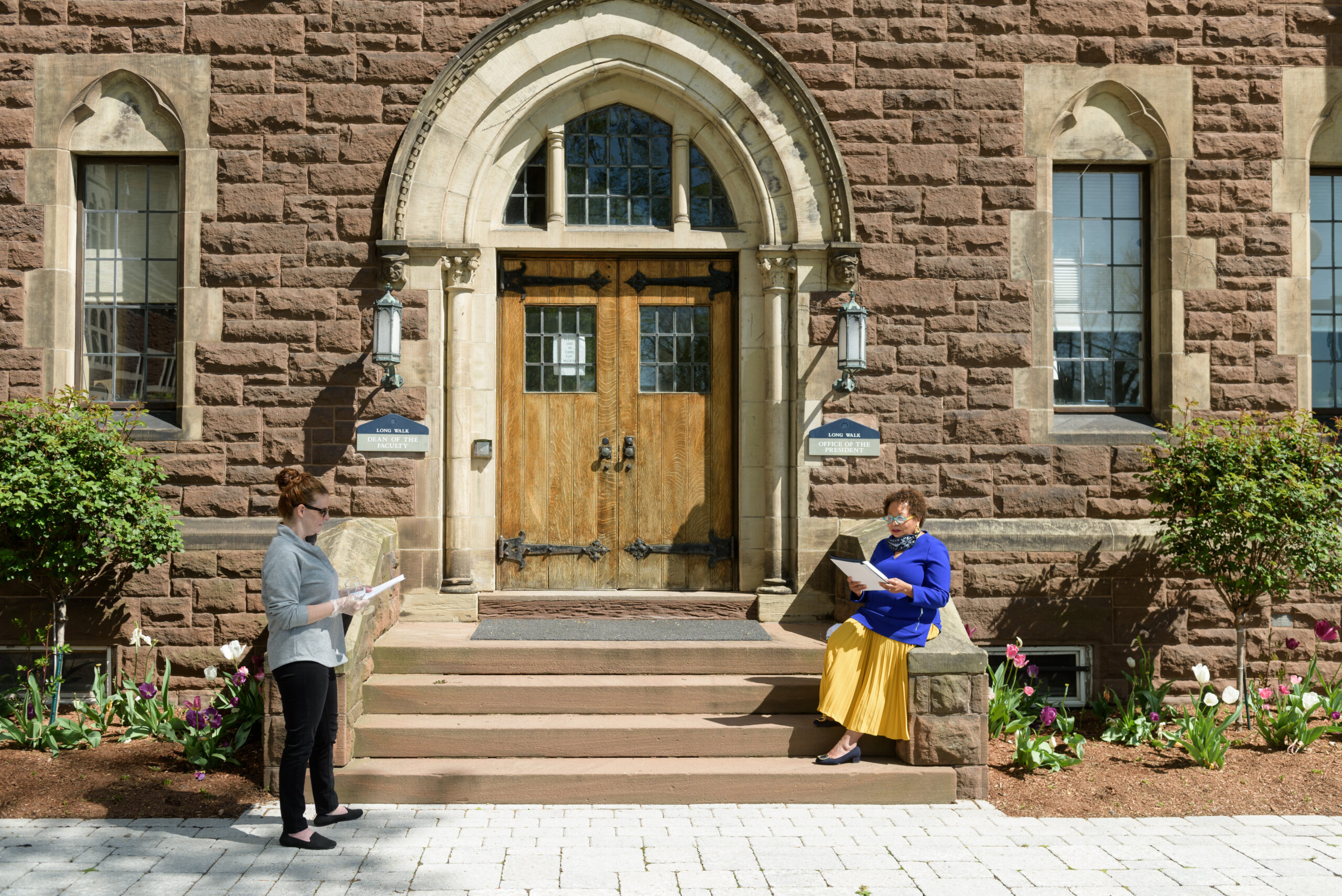
As COVID-19 forced a modification of college activities and events, President Berger-Sweeney reviews the script of a virtual Commencement for the Class of 2020 with Kate McGlew, director of major college events.
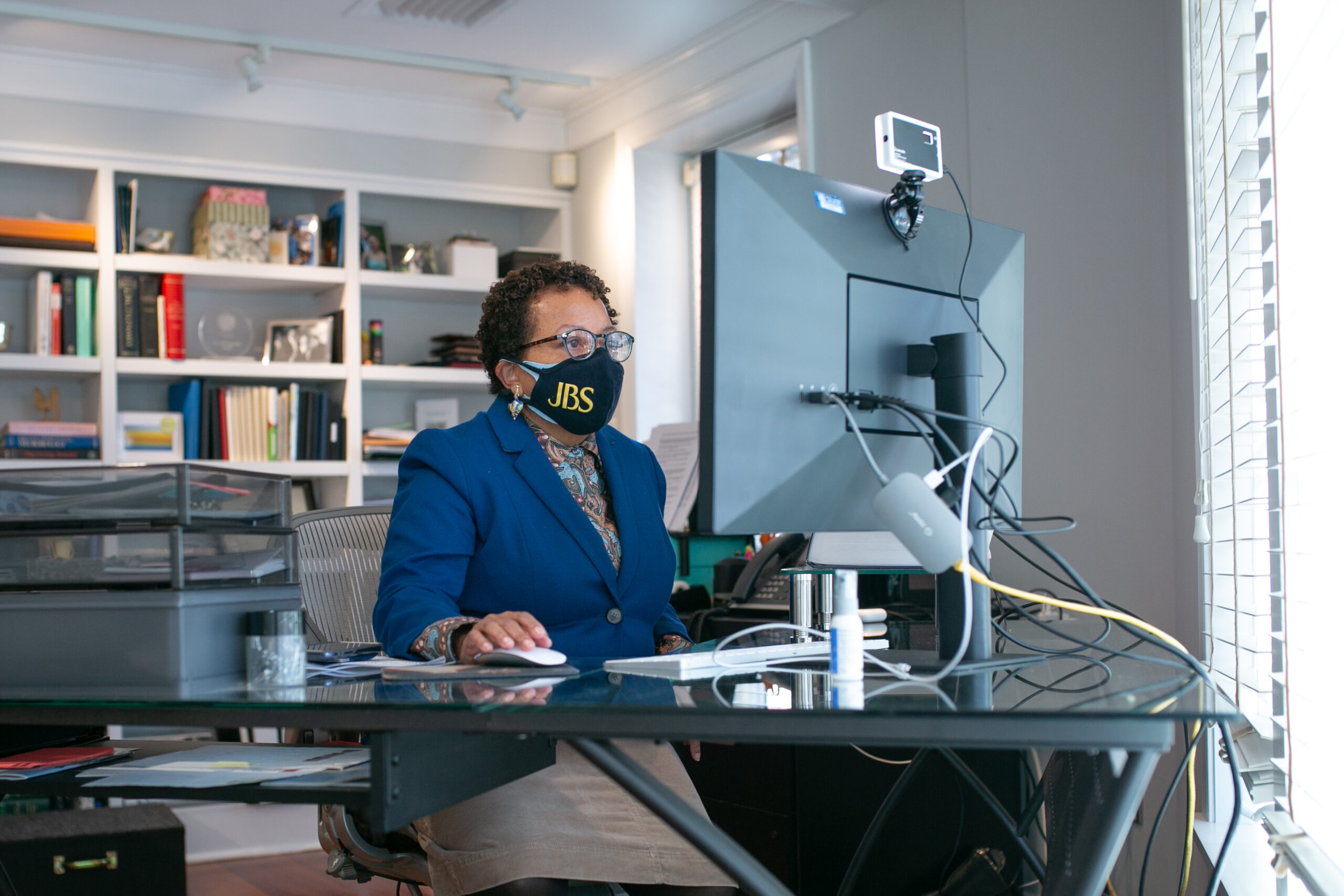
President Berger-Sweeney working safely in her office in 2020.
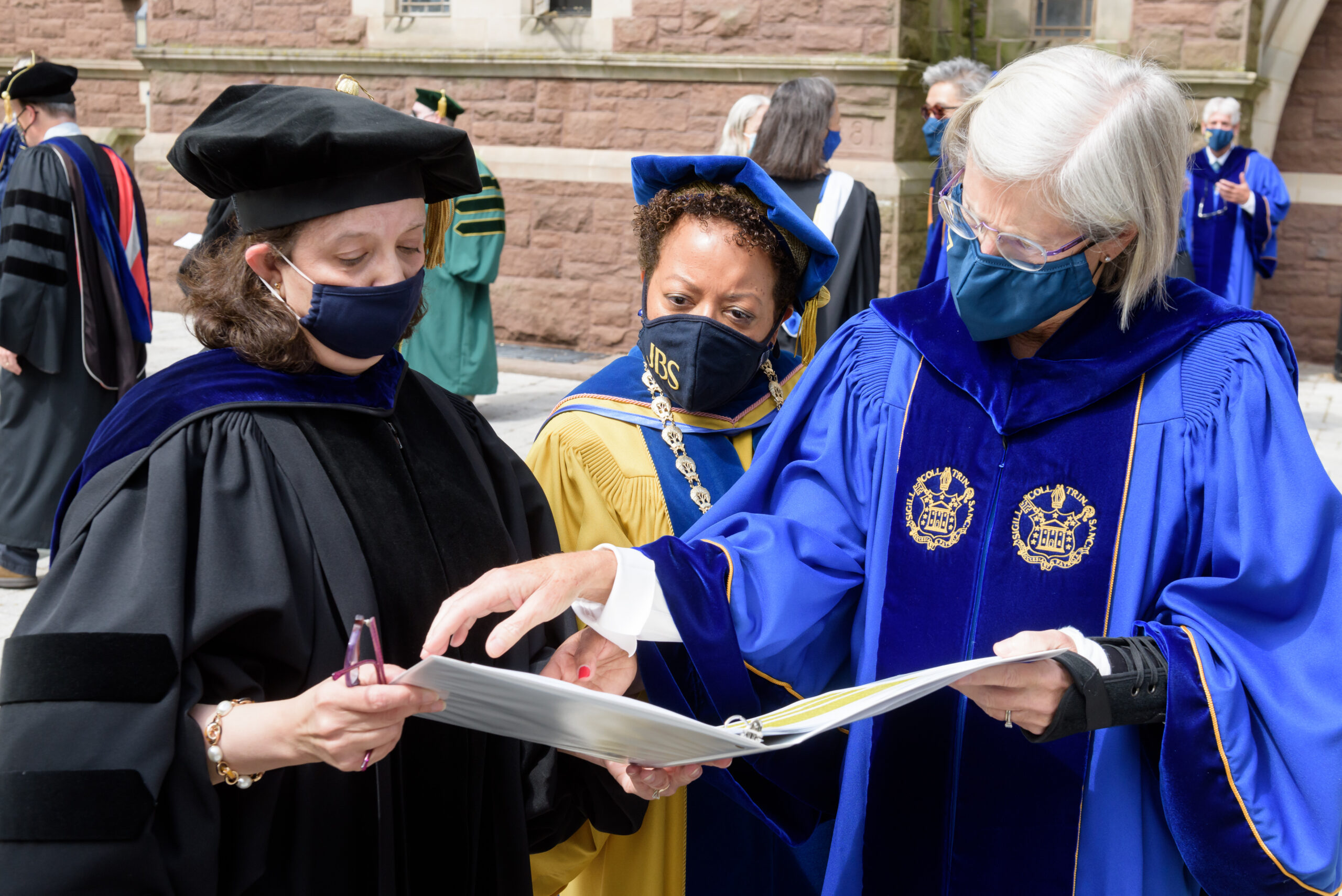
President Berger-Sweeney prepares for Commencement in 2021 with Vice President of Academic Affairs and Dean of Faculty Sonia Cardenas and former Chair of the Board of Trustees Cornie Thornburgh ’80, H’22.
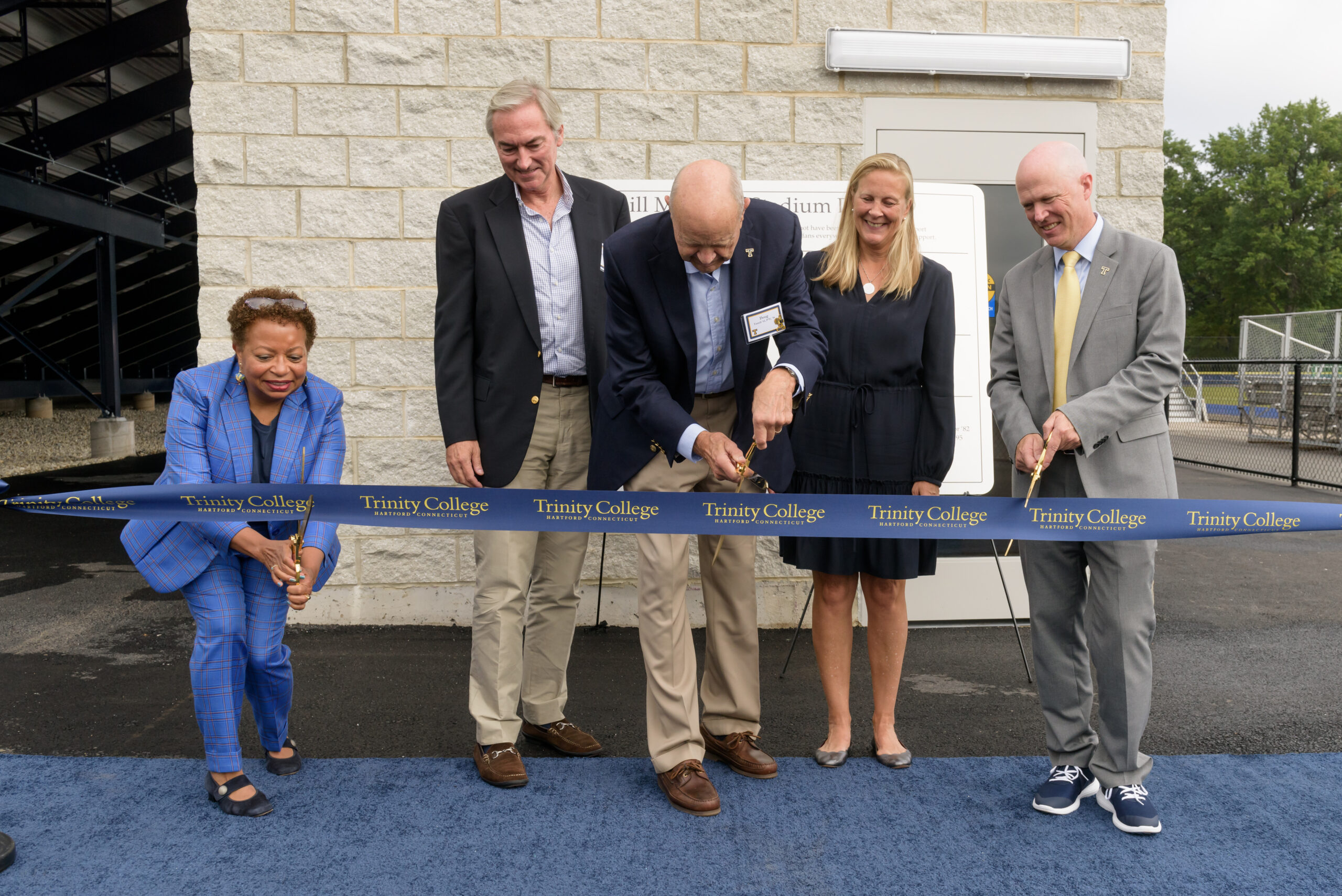
President Berger-Sweeney, along with (left to right) Art Muldoon ’88, Doug Tansill ’61, P’91, ’96, Peyton Tansill Muldoon ’91, and Athletics Director Drew Galbraith prepare to cut the ribbon on the new Tansill Muldoon Stadium.

Banty and President Berger-Sweeney give us a thumbs up at the Tansill Muldoon Stadium Dedication.
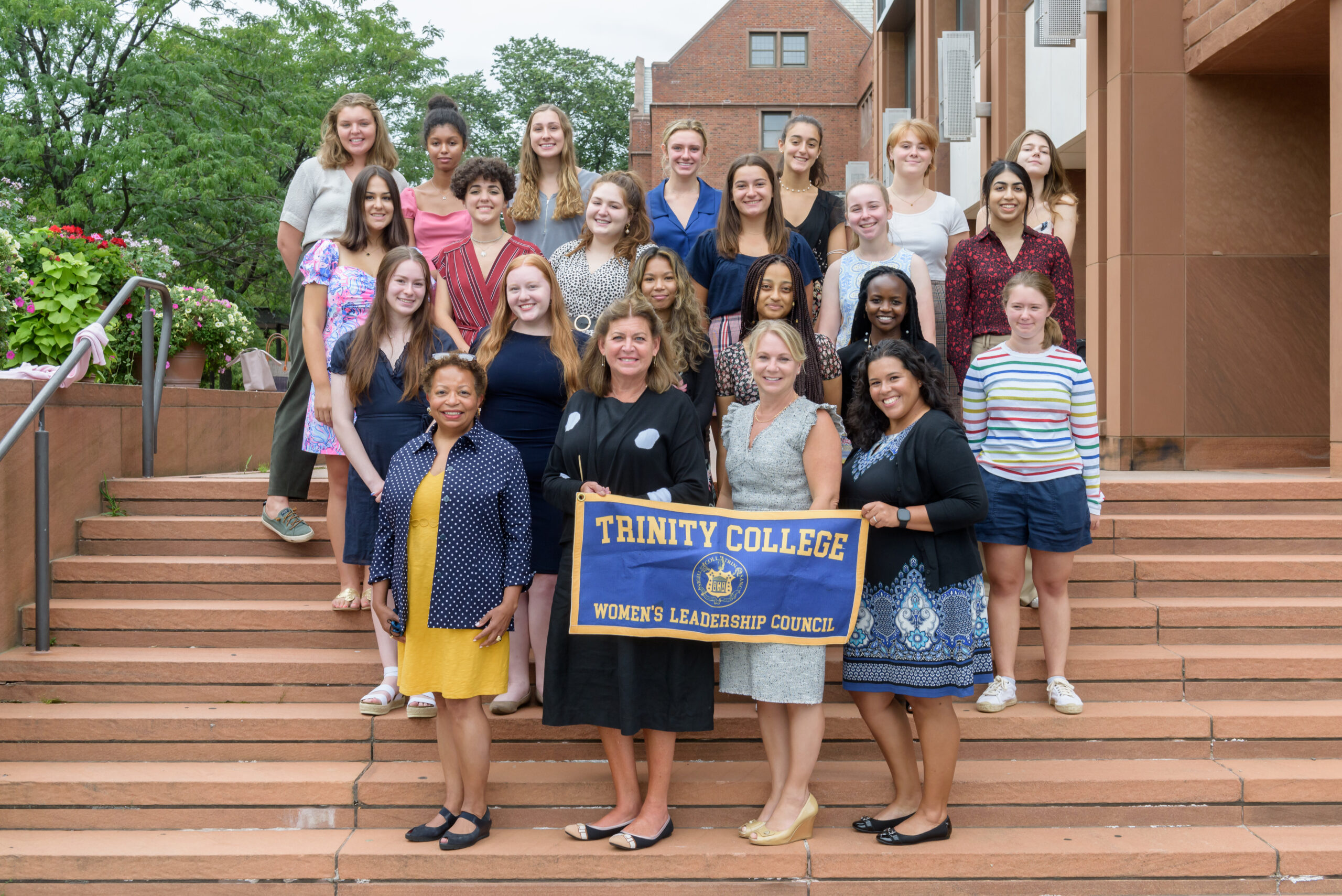
President Berger-Sweeney poses for a group photo with the Venture pre-orientation group and members of the College’s Women’s Leadership Council in 2021.
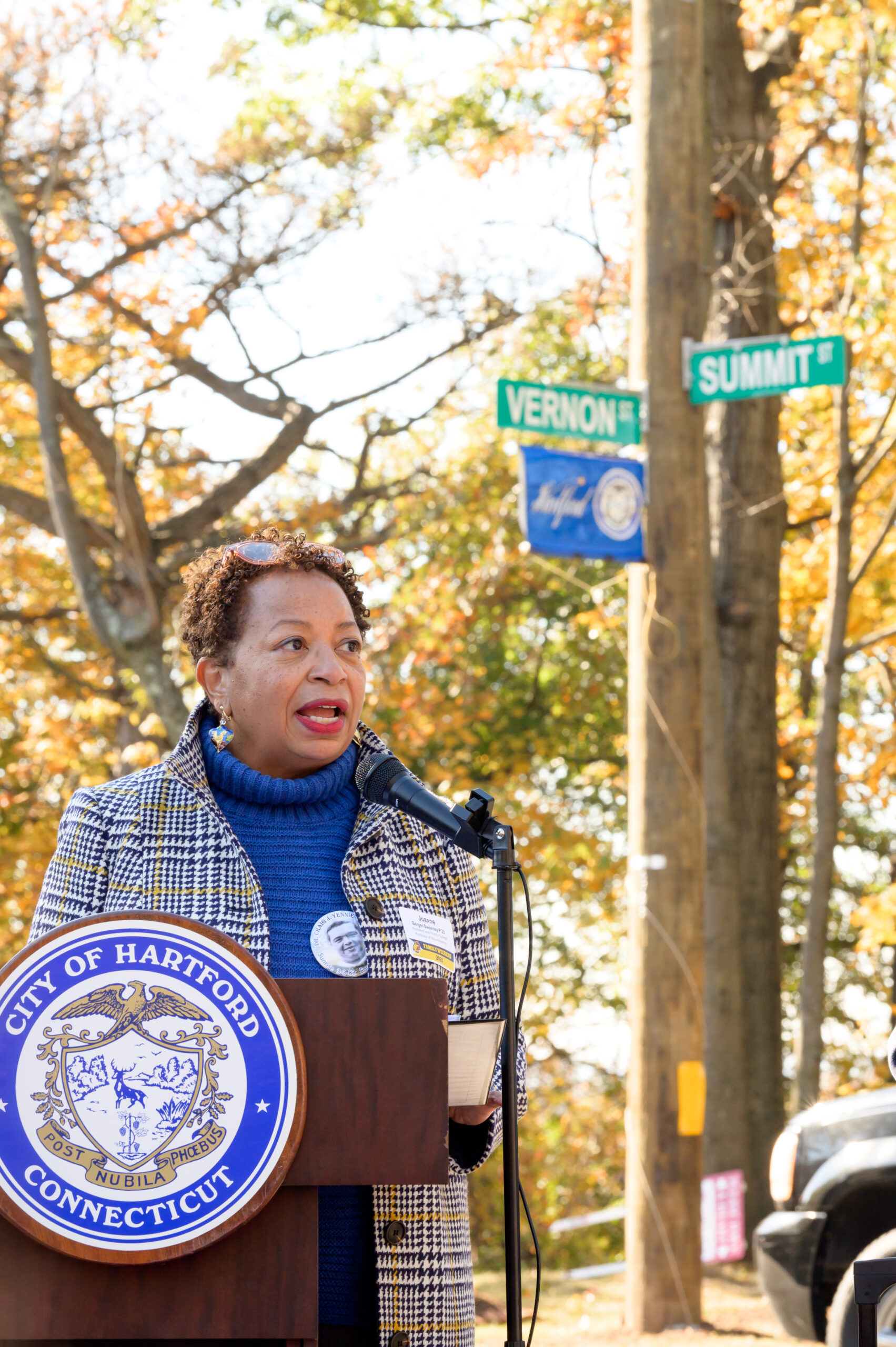
President Berger-Sweeney speaks as the corner of Vernon Street and Summit Street is dedicated in memory of Craig Yennie ’06.
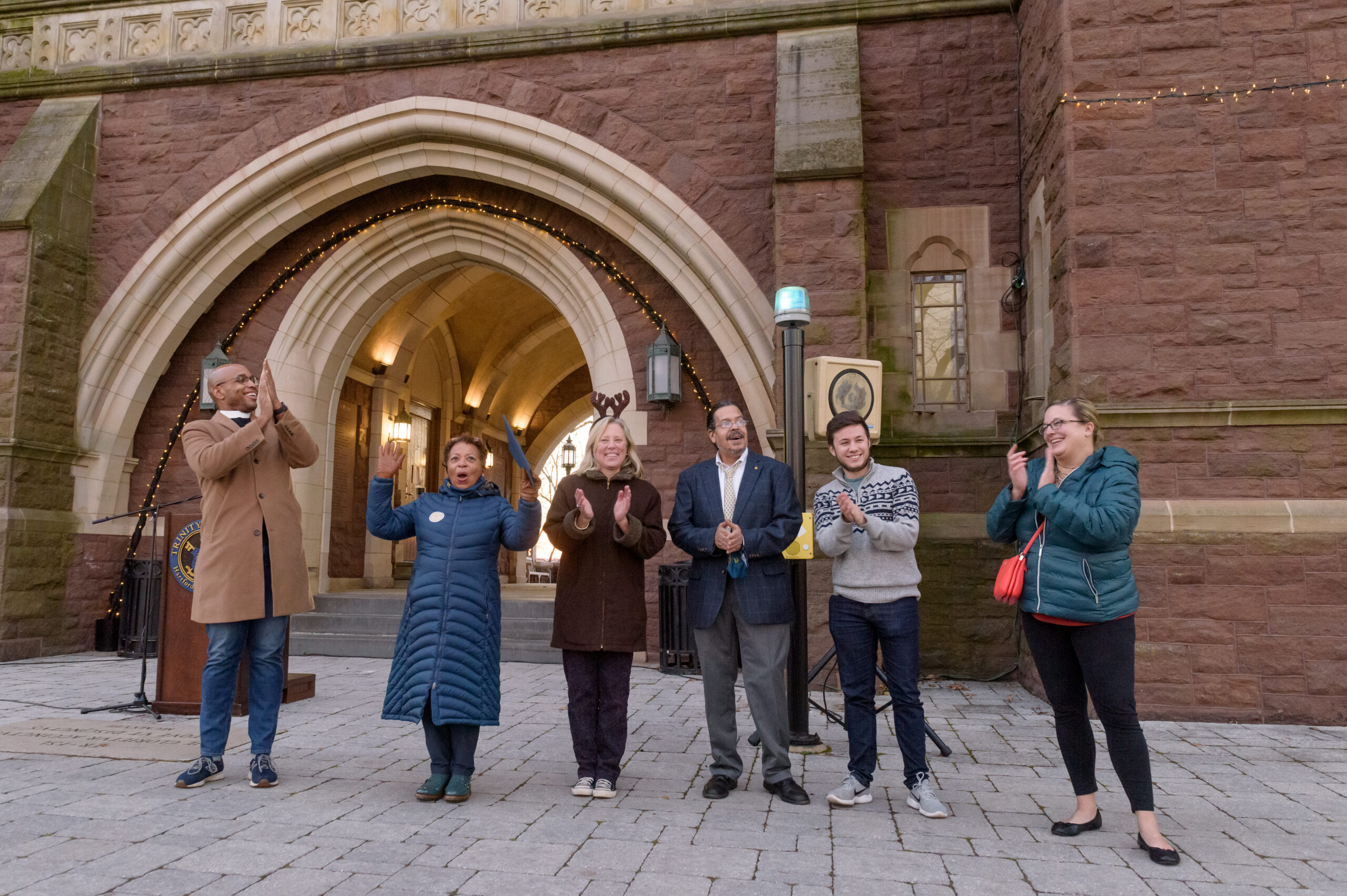
In 2021, President Berger-Sweeney begins a new tradition called “Light the Long Walk,” where holiday lights illuminate the heart of Trinity’s historic campus.
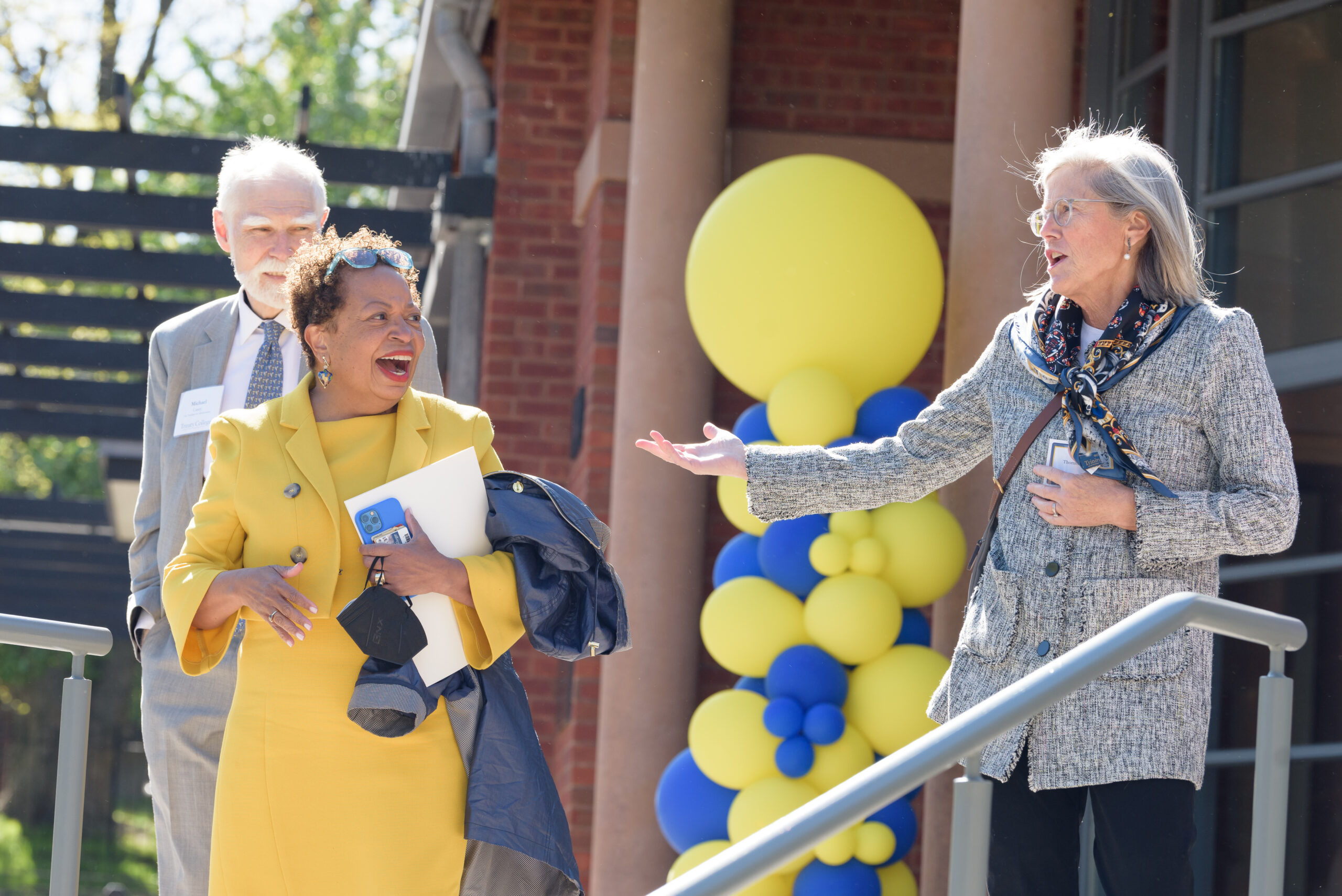
President Berger-Sweeney and former Chair of the Board of Trustees Cornie Thornburgh ’80, H’22 share a laugh before the dedication of the renovated Cornelia Center on Vernon Street.
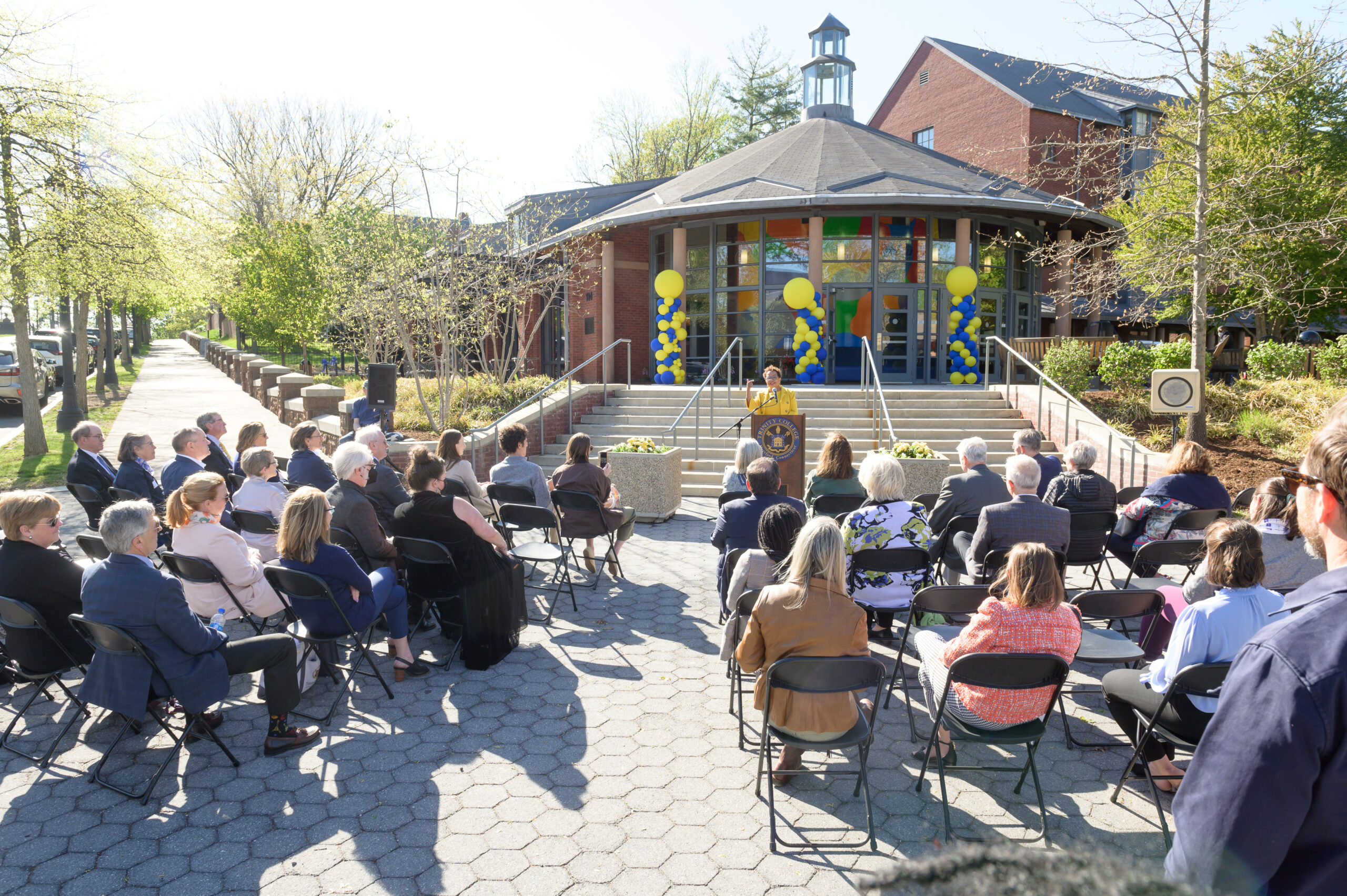
President Berger-Sweeney speaks at the 2022 dedication of the Cornelia Center (formerly Vernon Social), named in honor of now former Chair of the Board of Trustees Cornie Thornburgh ’80, H’22.
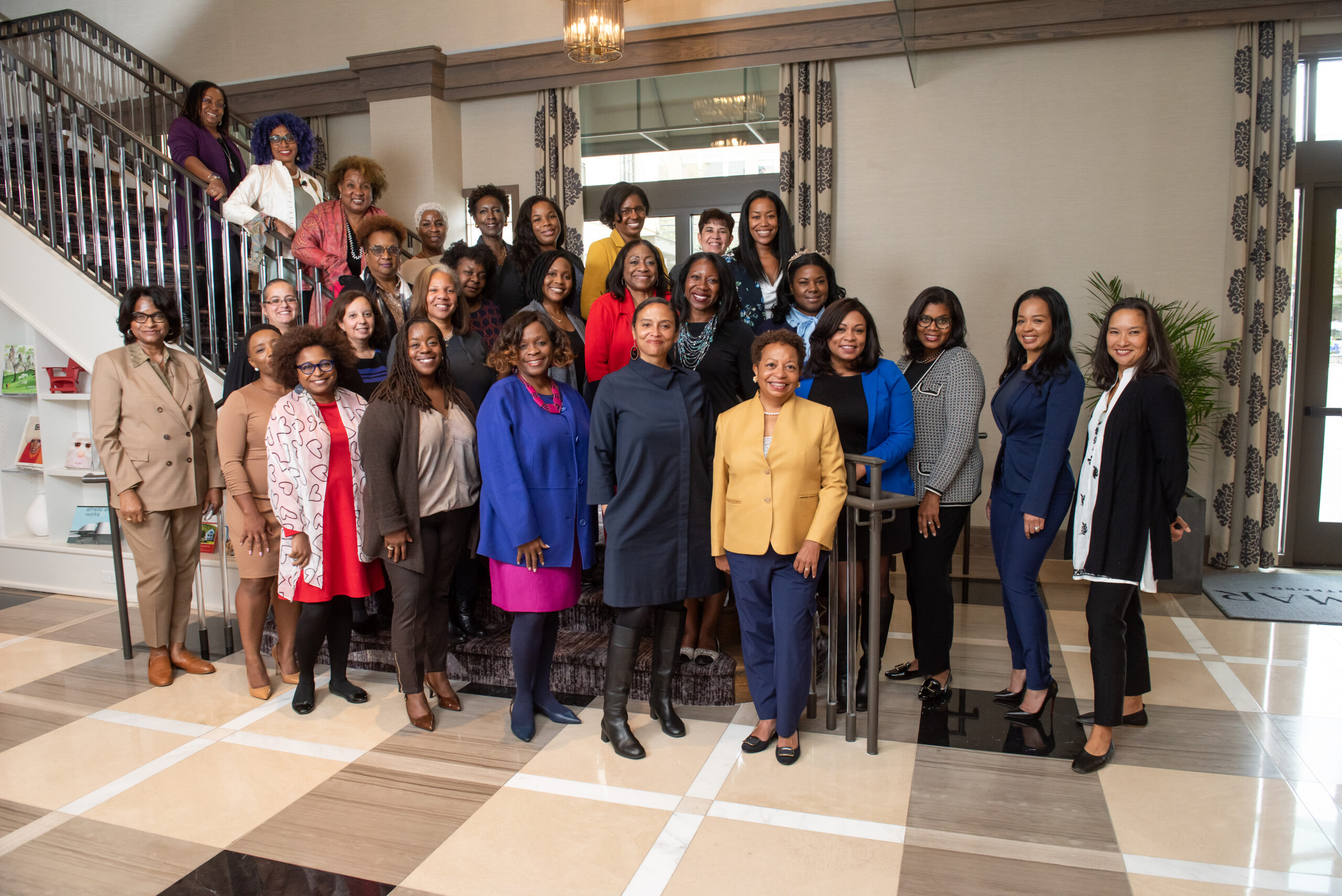
President Berger-Sweeney hosts “Convening of Women of Color” which assembles women leaders of color for a multi-day conference. The event was held in 2021 and 2022.
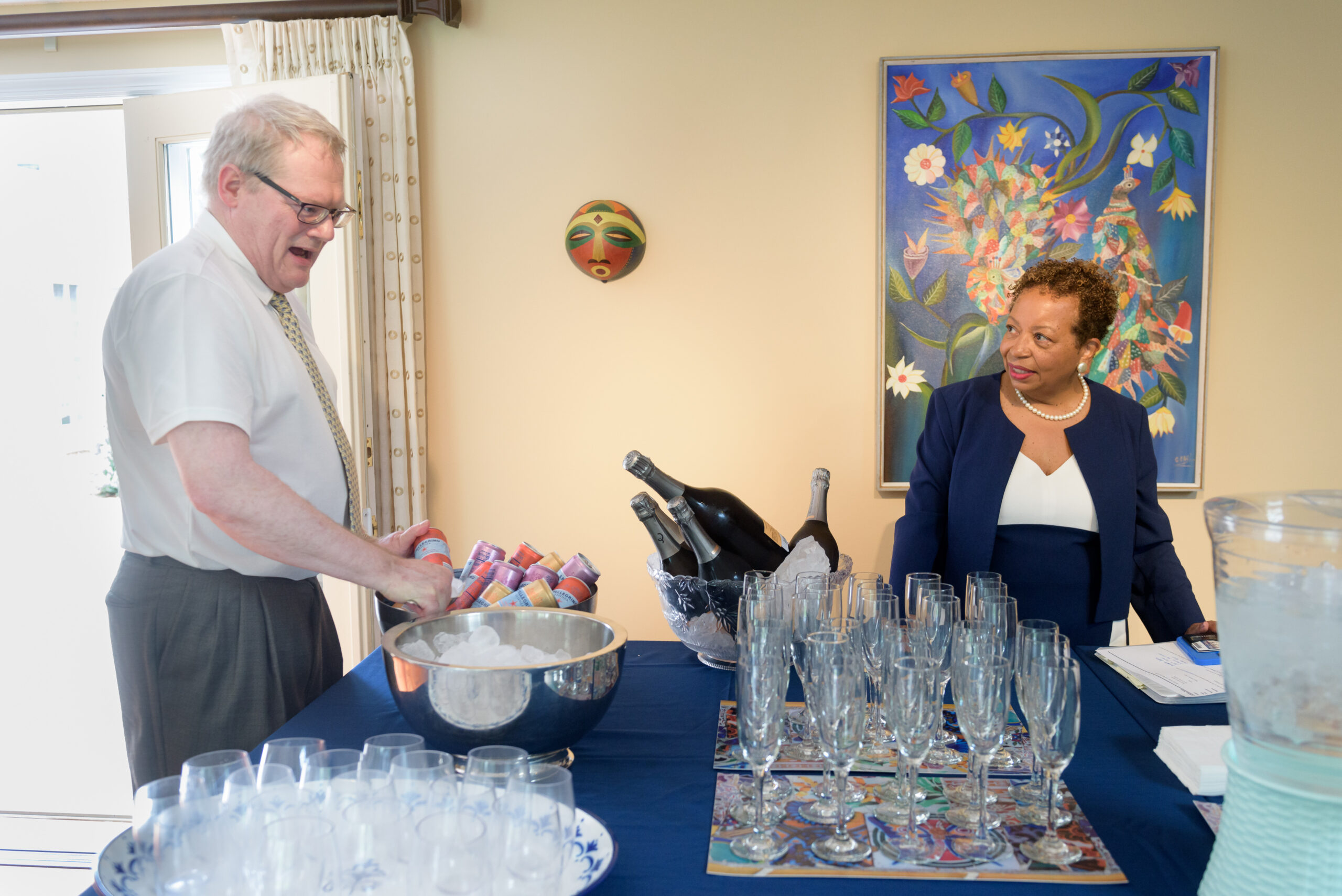
In 2022, President Berger-Sweeney and her husband Urs Berger discuss beverage choices before hosting a reception at their home on campus.
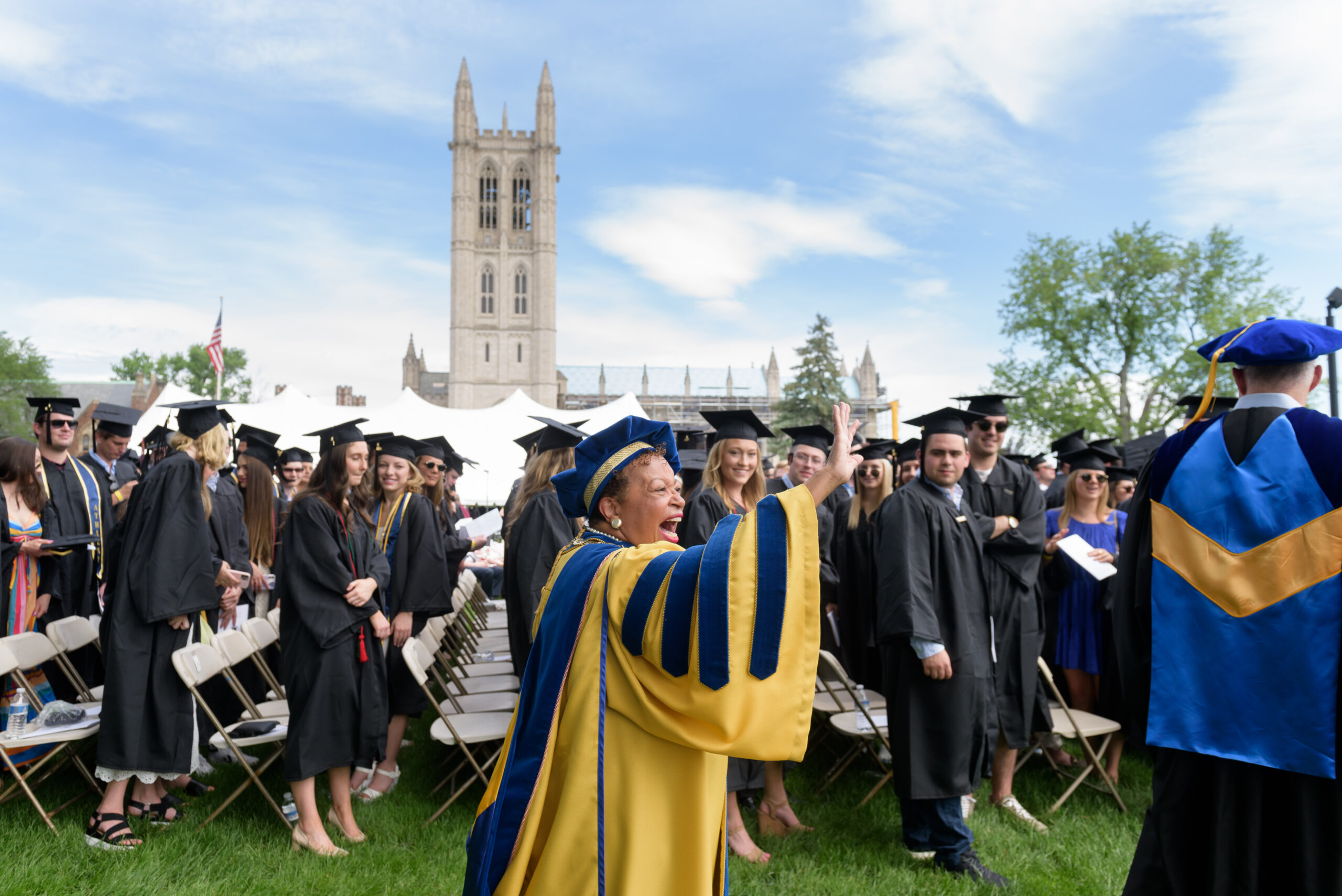
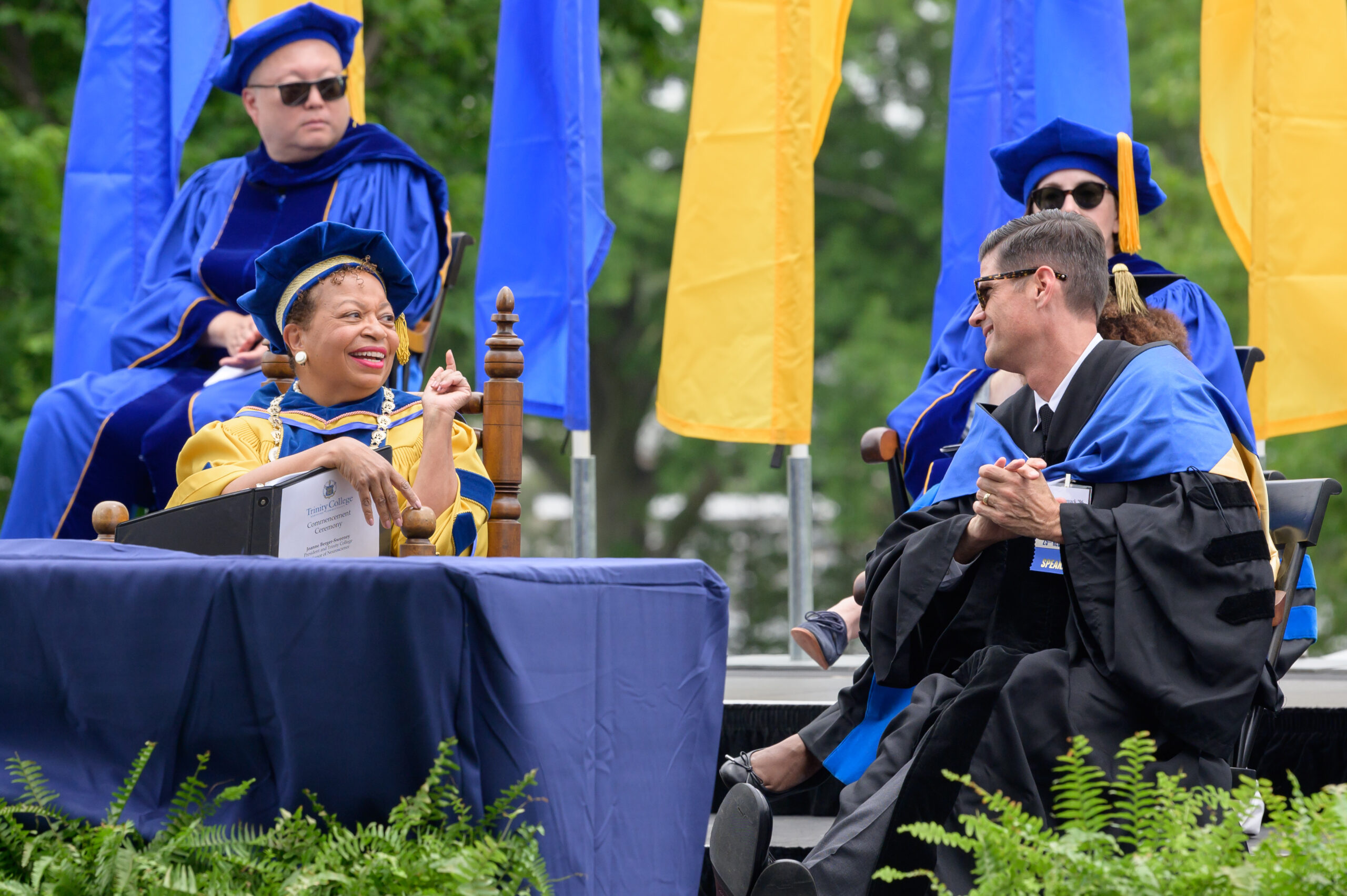
President Berger-Sweeney shares a laugh with filmmaker Will McCormack ’96 following his commencement address for the Class of 2020. Because of the COVID-19 pandemic, in-person commencement ceremonies for the Class of 2020 were held summer 2022.
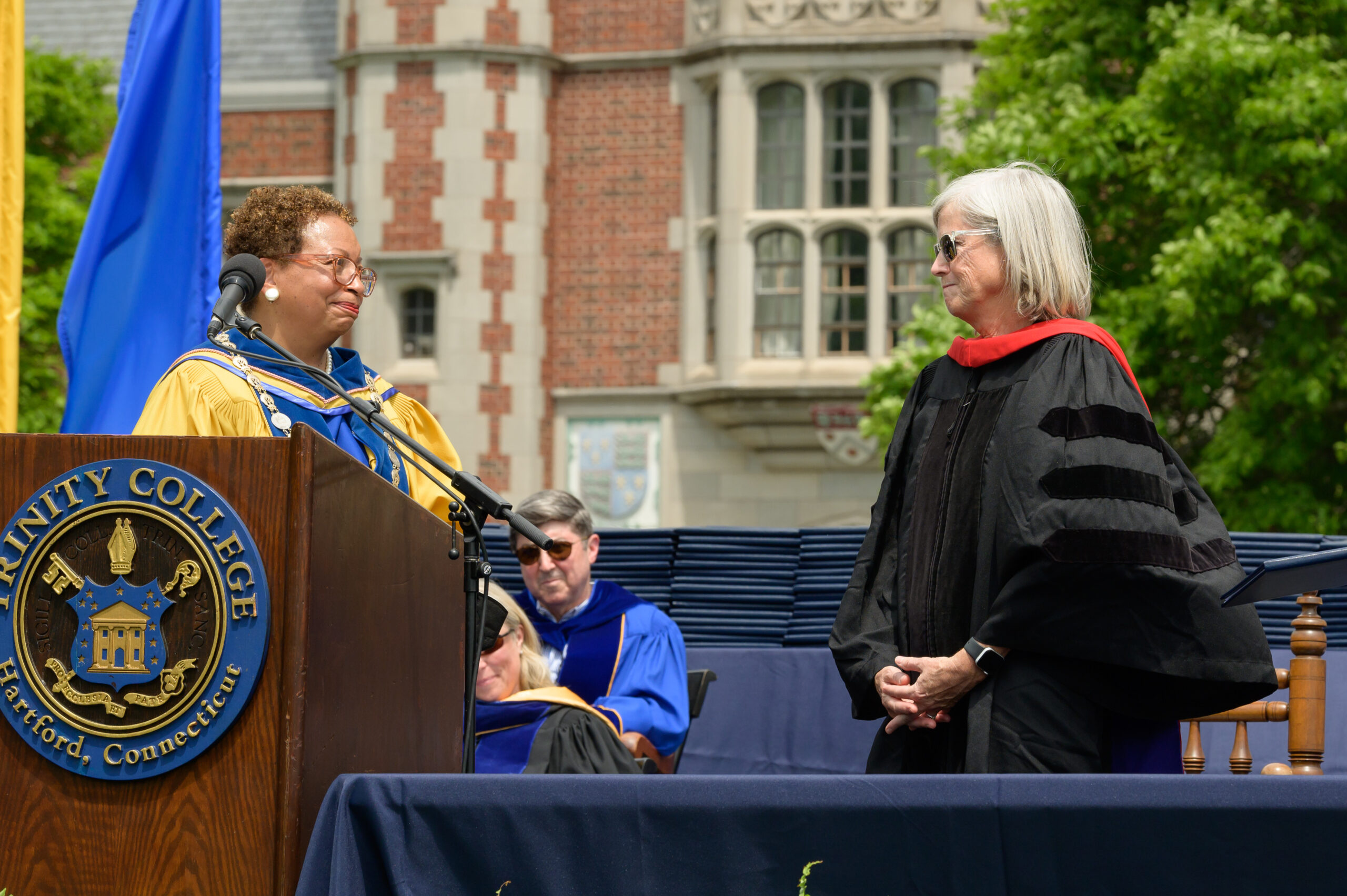
President Berger-Sweeney and former Chair of the Board of Trustees Cornie Thornburgh ’80, H’22 smile at each other as Thornburgh is awarded with an honorary degree in 2022.
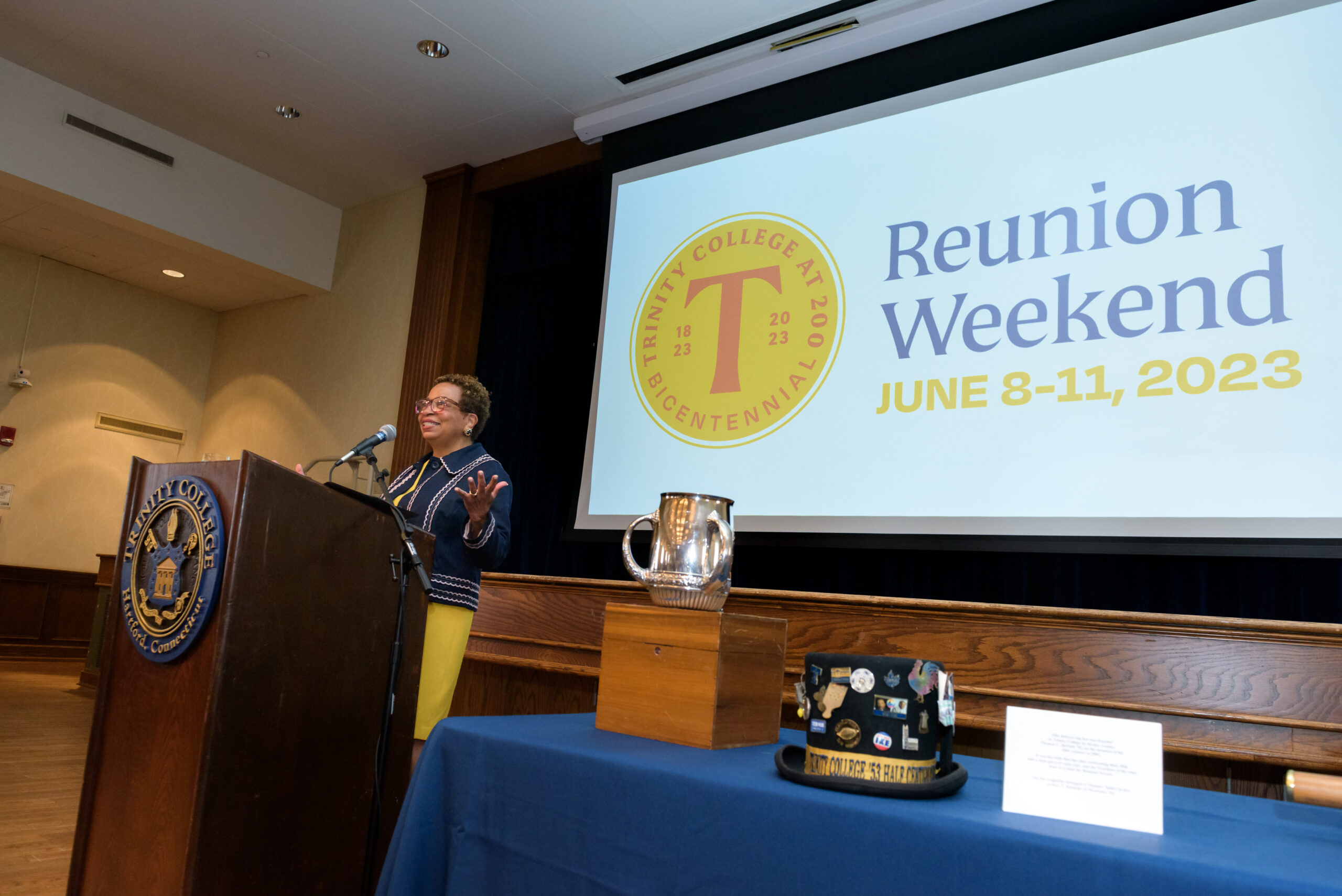
President Berger-Sweeney addresses the “Half Century Club” at the College’s Bicentennial Reunion Weekend. The event honors alumni celebrating more than 50 years since graduating.
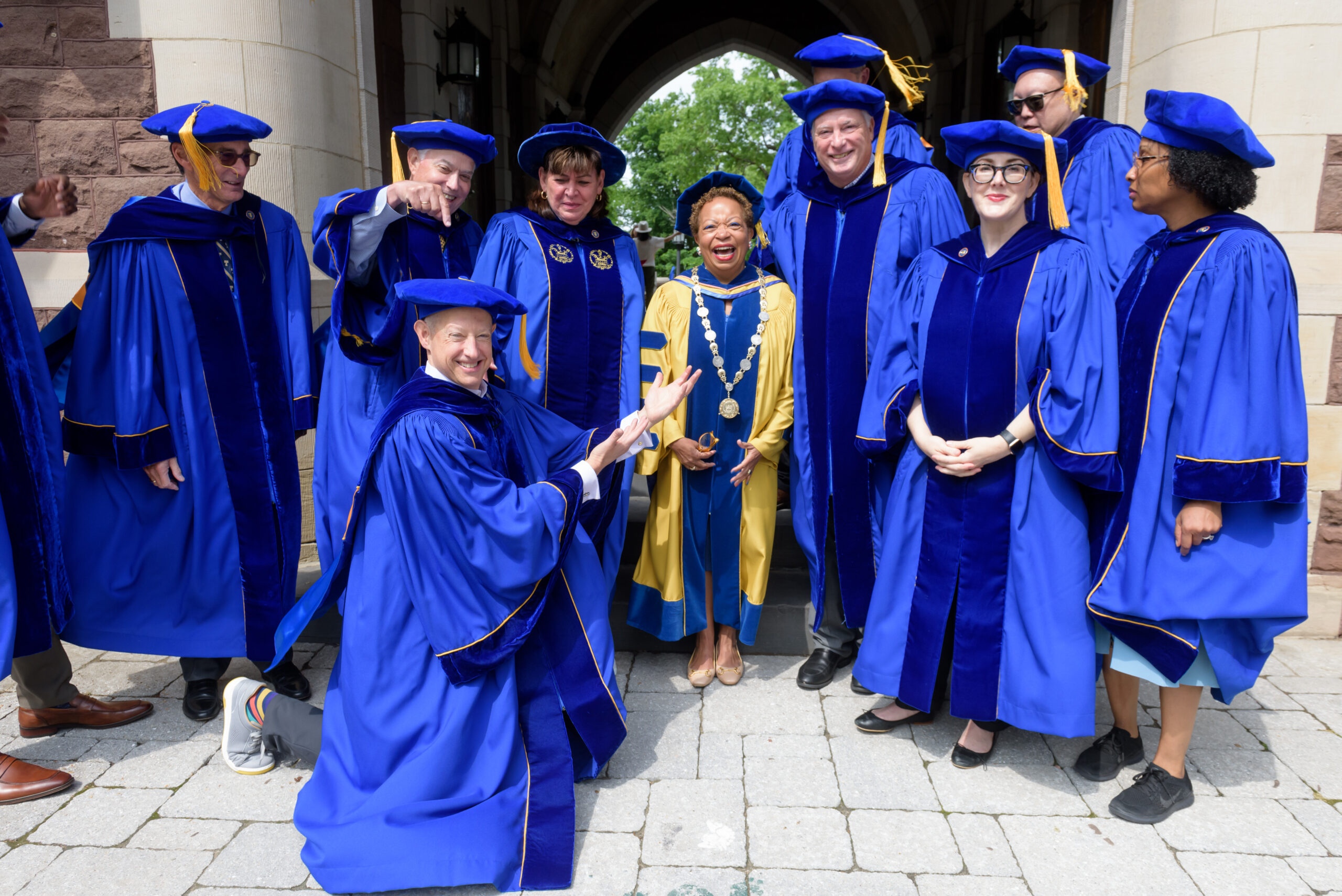
Trustee Dave Schnadig ’86 draws attention to President Berger-Sweeney as the trustees gather for a group photo before Commencement ceremonies for the Class of 2023.
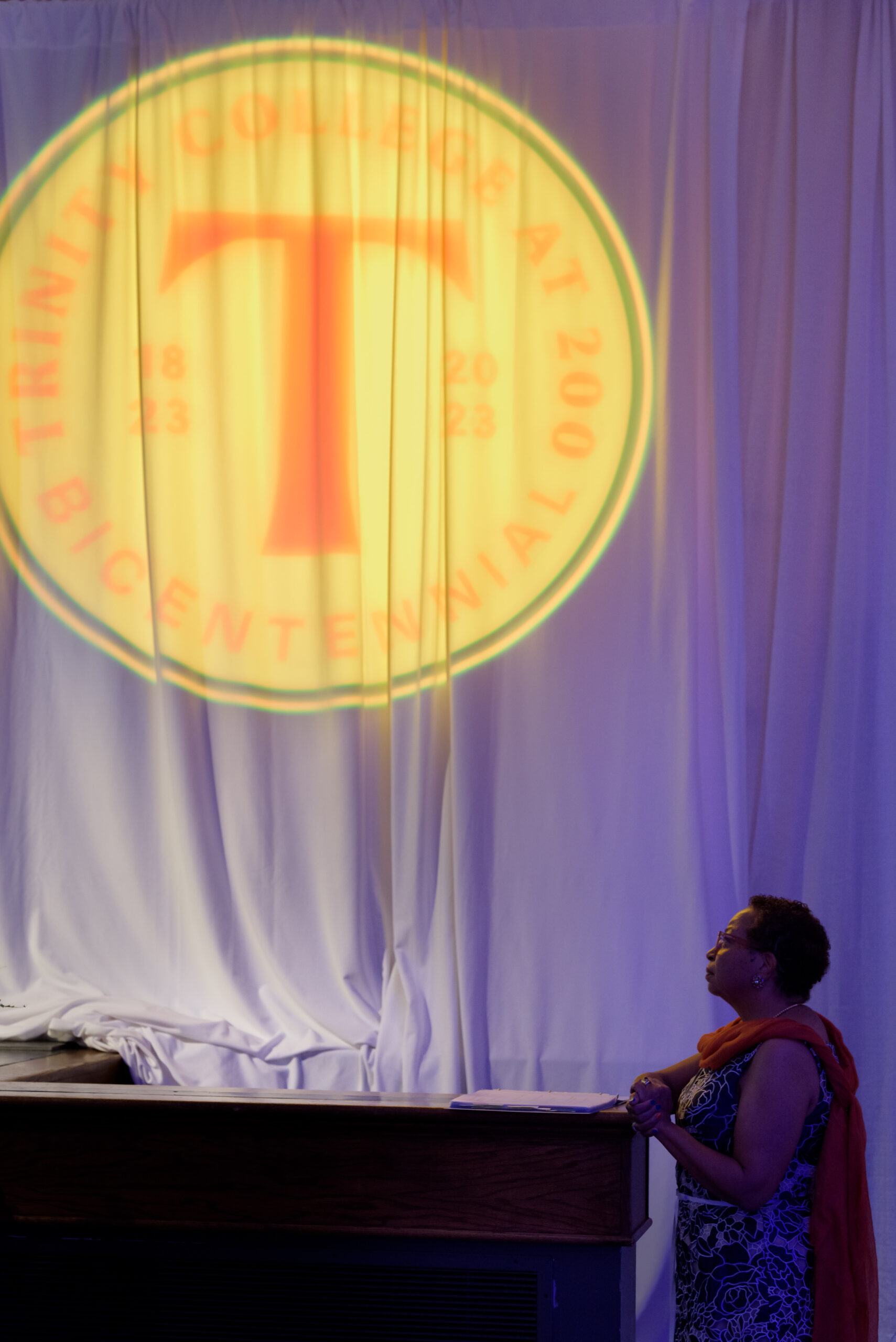
President Berger-Sweeney waits just off stage in the Washington Room of Mather Hall during a dinner reception for members of Trinity’s numerous leadership societies.
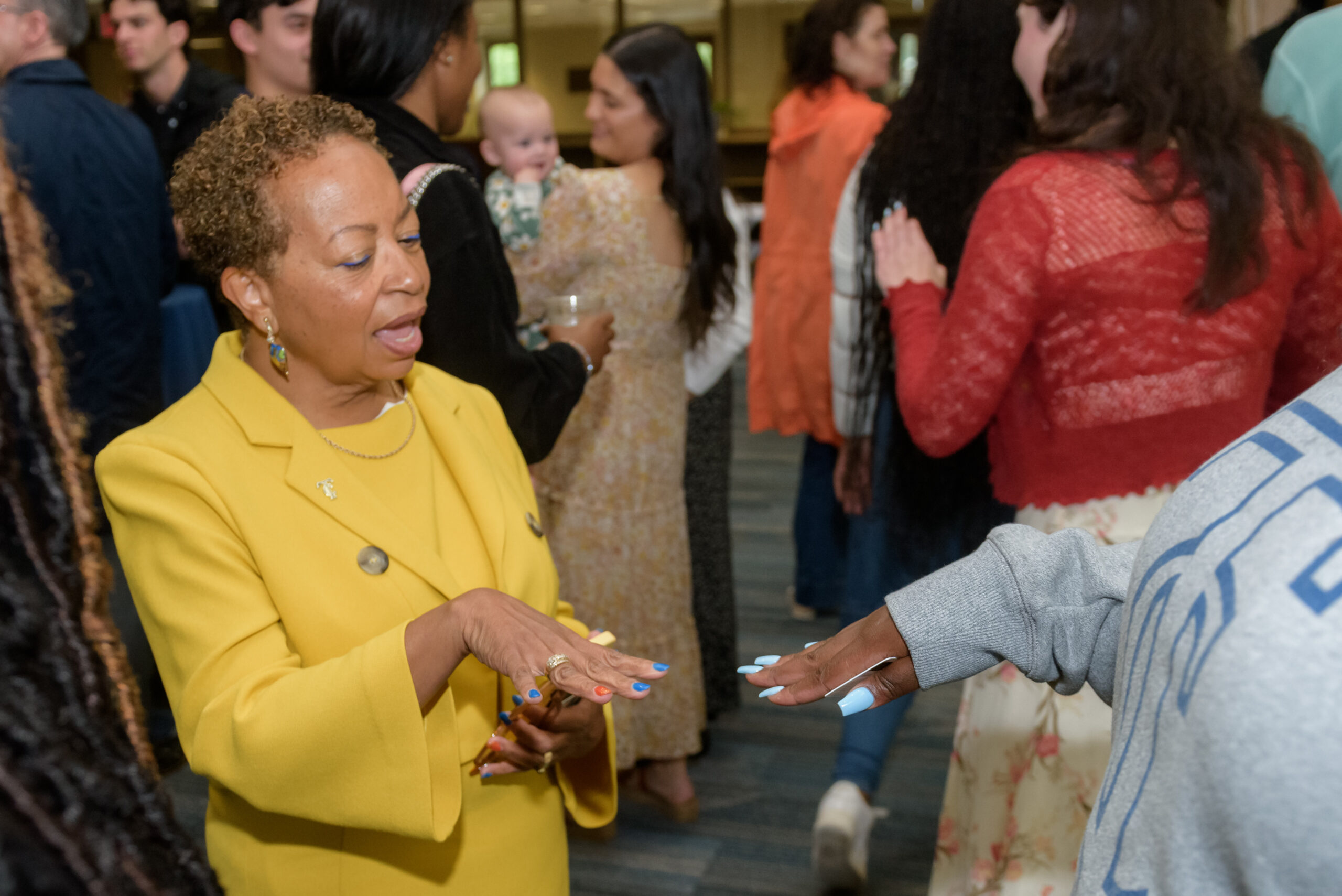
President Berger-Sweeney compares blue manicures with a member of the Class of 2023.
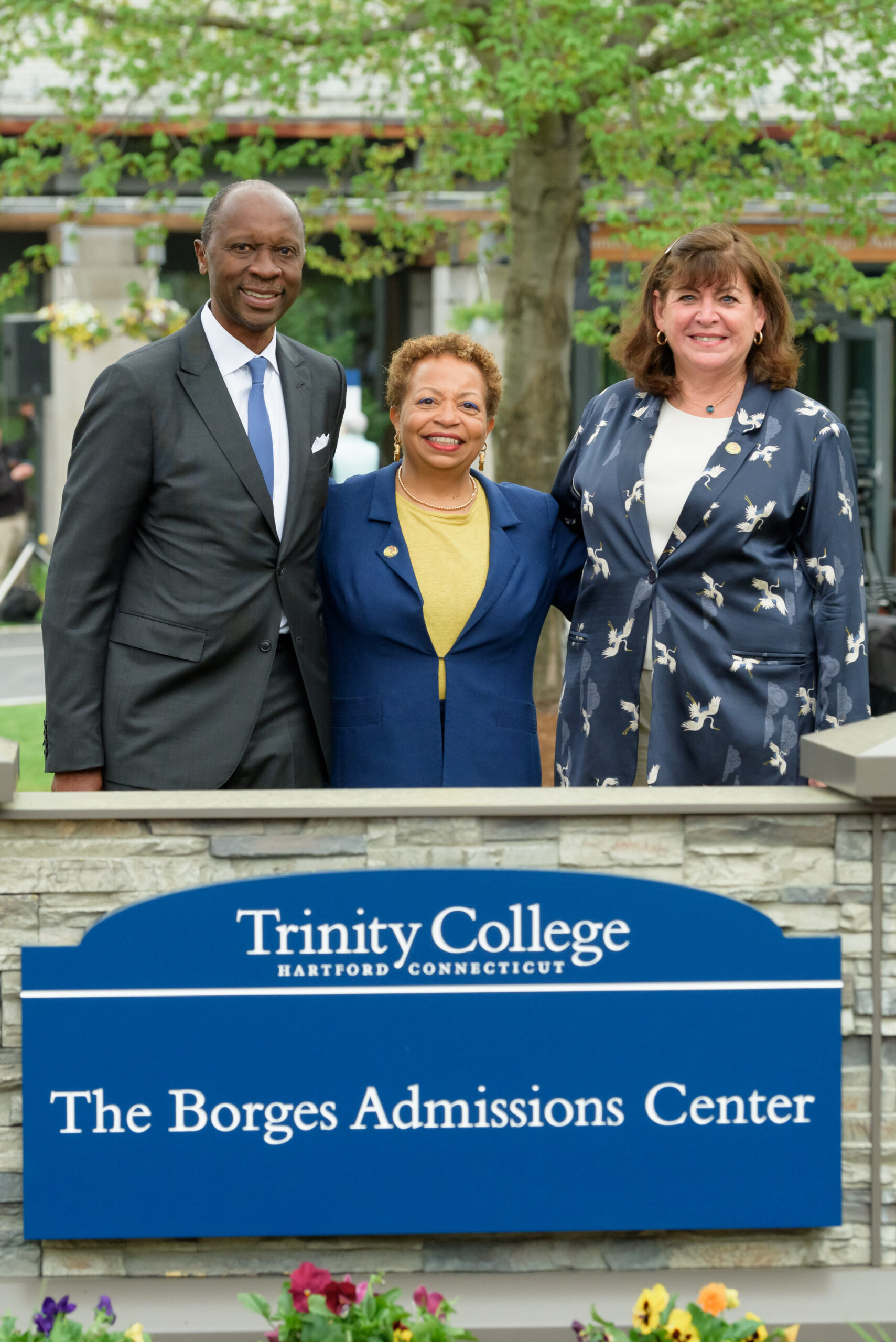
President Berger-Sweeney poses with Frank Borges ’74, H’20 and Board of Trustees Chair Lisa Bisaccia ’78 following the dedication of the The Manuel and Maria Luisa Lopes Borges Admissions Center.
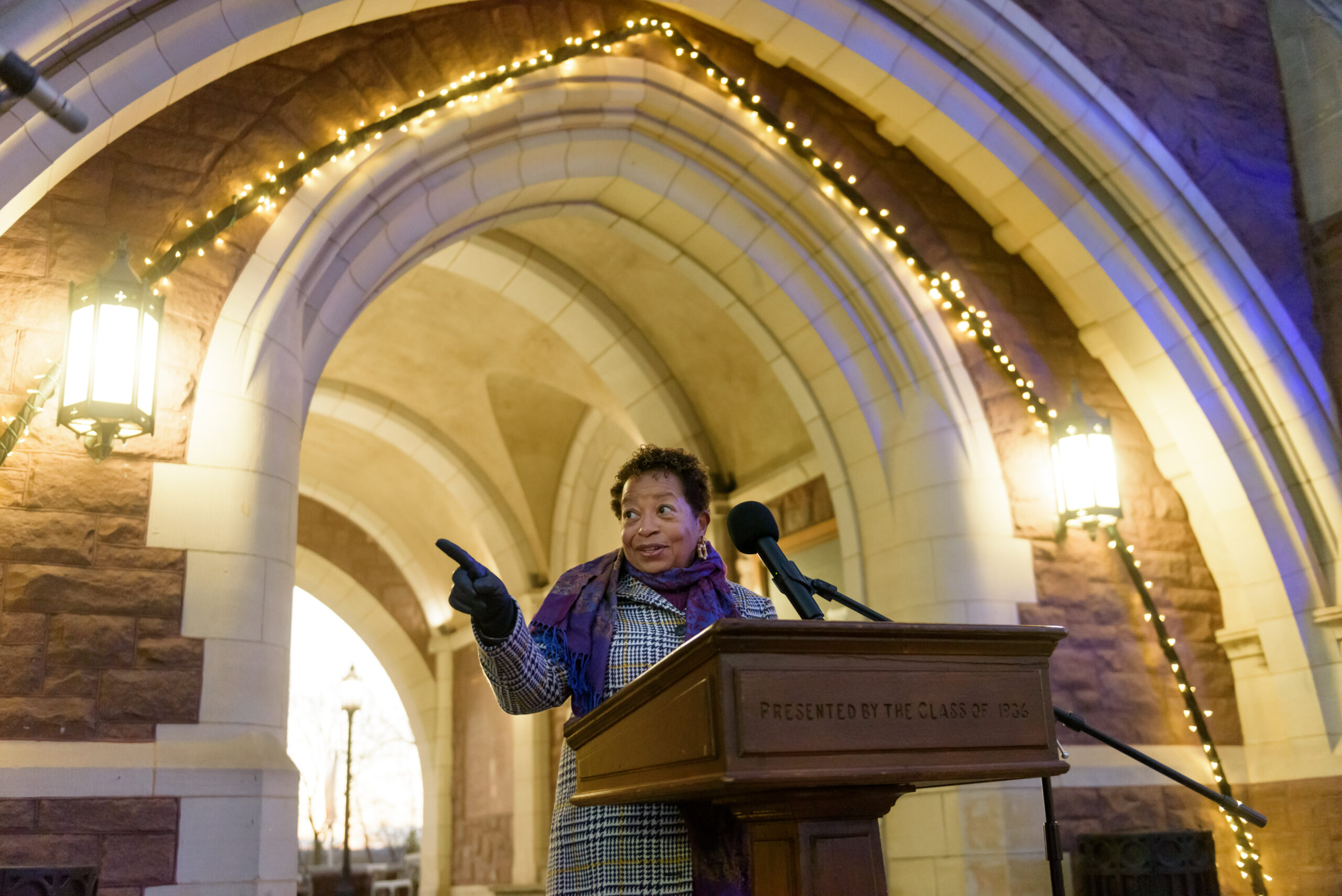
President Berger-Sweeney continues the new tradition of Light the Long Walk in 2022.
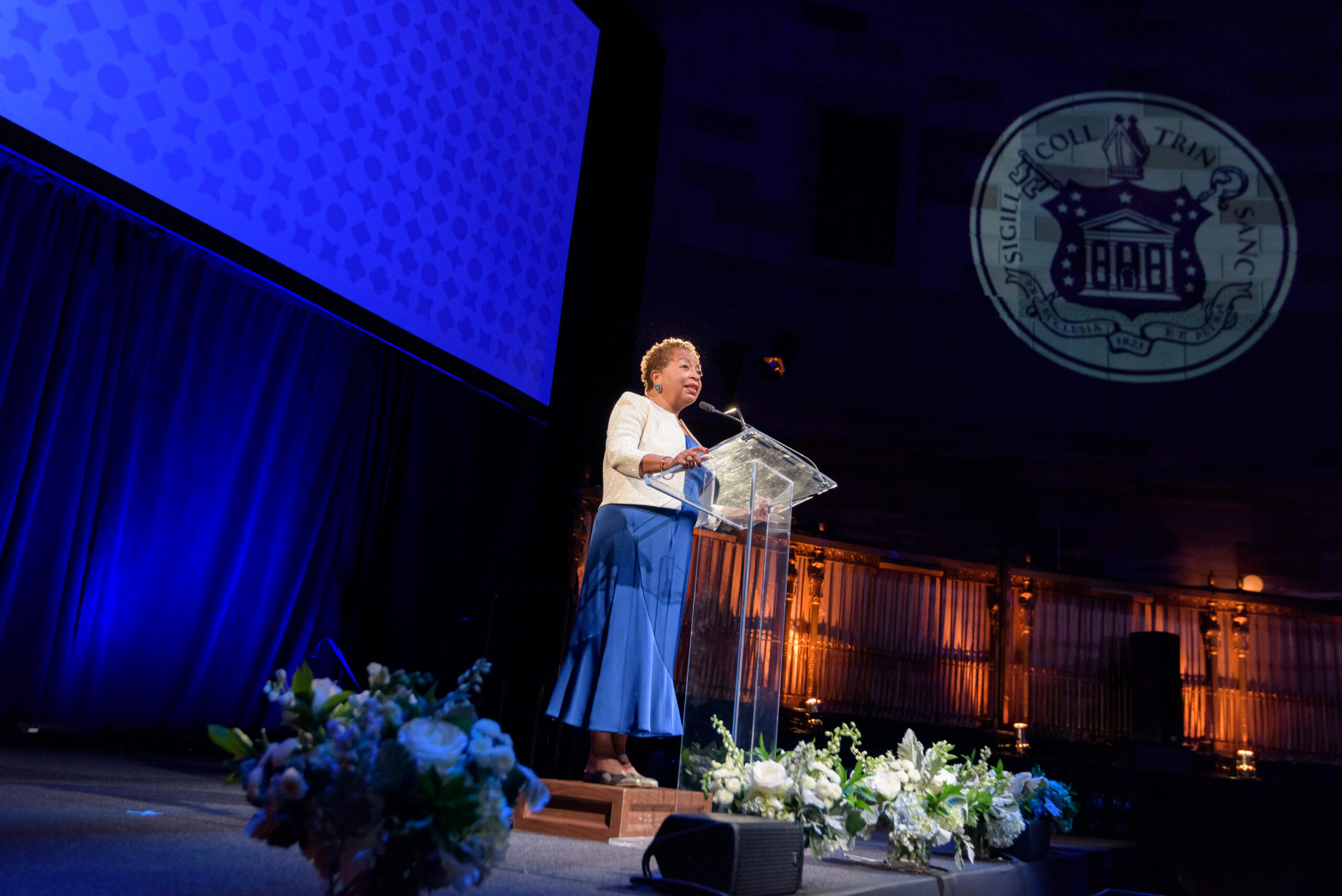
In November 2023, President Berger-Sweeney addresses the audience at the "All In" campaign public phase kickoff event at Gotham Hall in New York, NY.

During the Alumni Bicentennial Celebration and Reunion Weekend 2023, President Berger-Sweeney and Banty join the Samba Ensemble Procession to kick of the Bantam Birthday Bash.
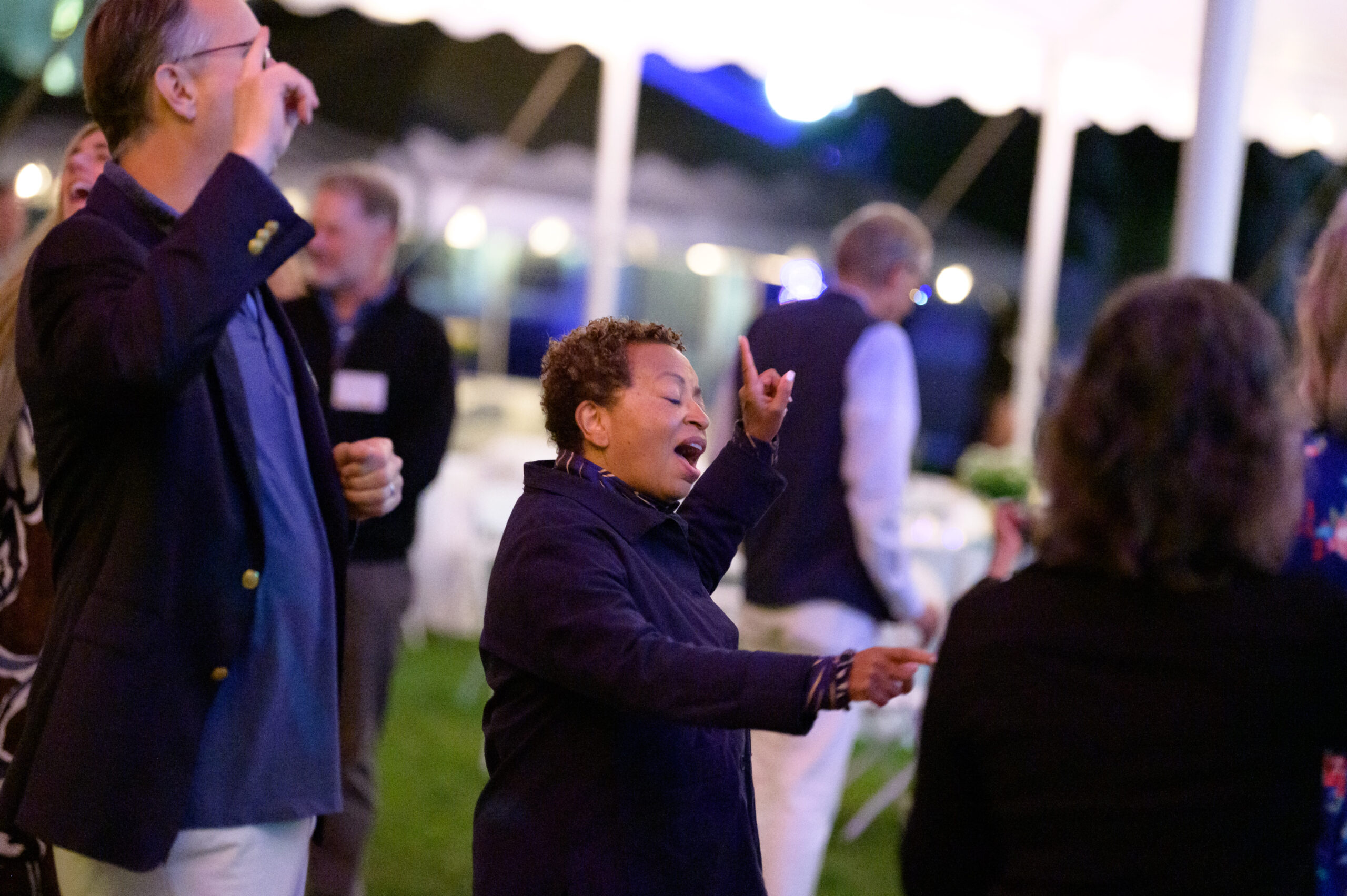
President Berger-Sweeney dances to live music during the Bantam Birthday Bash during the Alumni Bicentennial Celebration and Reunion Weekend, June 9, 2023.
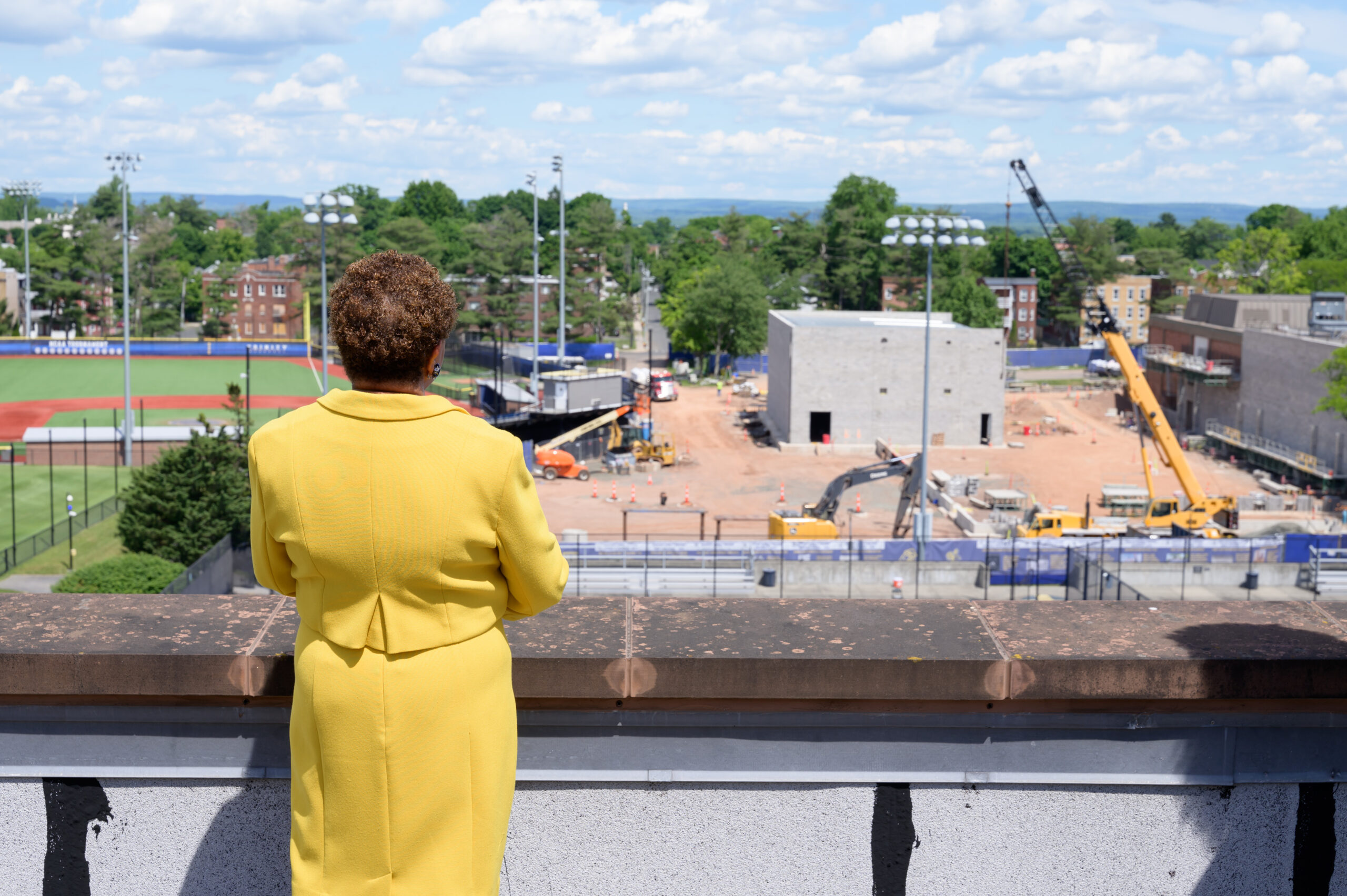
Following a portrait photoshoot on the roof of the Raether Library and Information Technology Center, President Berger-Sweeney examines the construction progress of the expansion of the Ferris Athletics Center during the summer of 2024.
